Dyna-Bass
? watts,
tube head,
1963
|
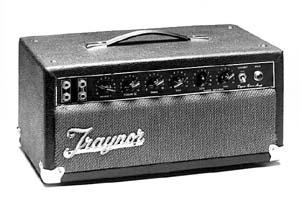
Features
silvery grey grille cloth
Yorkville [...] owns Dyna-Bass #0011 and [has] used it as a promotional tool.
Sound
-
Reliability
-
Price
CAD $395 [used], condition unknown, www.encore-music.org, Scarborough, Ontario, Canada, February 7, 2001
Very hard to find. [Feb 2002]
Rating
-
Rate the Dyna-Bass...
 Dyna-Bass, front view, angle (apparently the same as the following) Dyna-Bass, front view, angle (apparently the same as the following)
 1963 Dyna-Bass, serial number 0011, front view, angle 1963 Dyna-Bass, serial number 0011, front view, angle
(Craig,
Dan Lear,
Pete Thiessen,
Sean Kilback,
yorkville.com)
|
|
|

|
YBA-1 Bass-Master
40-50 watts,
tube head,
1966, 1968, 1972
|
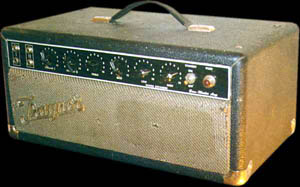
Features
Two channels, deep (bass), and bright (guitar); each has an attenuated and a
normal gain input (like the old Marshalls); no reverb
Volume control channel one, channel two; treble, bass, low range expander, high
range expander (passive); the low range expander may sound like a mid-range, the
hi range expander may sound like presence (on Marshalls or Fenders) to some (the
section is a virtual clone of that of the Marshall JTM-45); standby switch;
pilot light; ground and on/off switch; no fan
One main speaker output, impedance is not indicated (runs fine using a cab of
eight ohms, also often operated with four ohm loads), one "extension" speaker
output also without indicated impedance. A YBA-1 has a nominal 8 ohm output, and
the two speaker jacks are wired in parallel.
Runs on less than 440 volts, weighs 39 pounds
Dimensions: 8"x18"x10" (HWD); weight: 40 lbs.
Dimensions: 19"x10"x13"; weight: 39 lbs. (source: Catalog)
Silvery grey grille cloth;
Original layout was very close to the tweed Bassman and the Marshall JTM-45
50-watt models; noticably huge big heavy transformers are a Traynor hallmark in
these units up till the approximately 1972+ models;
Early models were tube rectified (5AR4) and used two 7027A power tubes. They feature a 'flip-top' design that allowes the top of the head to open like a lid. Bass-Masters are identical in appearance to the Voice Master/Signature;
Middle versions: Solid-state rectifiers started showing up in approximately mid
1966. A 1967 YBA-1 is reported to feature a diode rectifier. The used tubes are, as indicated in the amp: Two 6CA7s (replaceable by EL34s) and three 12AX7As (also called 7025s or ECC83s); plate voltages have always been a question on these units, but I think this may be largely because of confusion with the YBA-1A models that run VERY high plate voltages; most of the YBA-1 models probably come in somewhere +/-450 volts (one has reported 425 volts on plate, another one ca. 437 volts); this may have gotten higher after 1971, but into the summer of 1971 I'd expect the plate voltages on 6CA7s to be down substantially from the YBA-1A; have the chassis sliding-in ala Fender.
Last versions have that easily identified rubber and 'chrome' molding running
around each end of the head cabinet; mine is from 1971 and is this last version;
1972+ models have no choke; [a 1978 is] black with the black plastic fabric and
[has] the baby bumper trim, [it has] two 6CA7 and three 12AX7A tubes in it [and]
no fuse holder, just a red reset button
I put Mullard EL34s in my YBA-1. [...] When [the YBA-1] ran on 7027s, it was a rock machine (think Black Crows, Zep, etc.). It probably has a bit less bottom end and more mids and highs now.
I have swapped out the 4M volume pots for 1M, and put a 47K resistor in the NFB loop. These mods are worth doing to any Signature/Bass-Master, IMO.
Sound
It's got the best tone, but it's not the loudest (when used for bass).
Better sound as a Fender Bassman; lower powered, would work just fine in a blues
or lower volume setting (when used for bass or guitar).
A fine guitar amp.
Sounds like a snarling early Marshall.
Both the YBA-1 and YSR-1 each have 4 input jacks, so I can jumper the channels and use both the bright and normal volumes to adjust my tone. This really works great!!!
Reliability
Very solid construction.
Old and still going strong.
Professional repairman required, although schematic is included, weird defects
possible.
Price
Mint 1978 YBA-1 and 1977 YT-15 set bought for [US?] $100. It must have been one of the last YBA-1 Traynors made. The YBA-1 serial number is 8011108 the YT-15 serial number is 7125596.
CAD $253 used, bad price, amp in average (5/10) condition, Song Bird Music,
Ottawa, Canada, summer 1998
US $125 [used], needed a little work but playable, cheap buy
US $299.99 [used], seen at www.brocktonmusic.com/amps.html, September
1998
CAD $189 [used], good condition, seen at Used Music, Ottawa, September 1998
CAD $150 [used], shabby condition, very early (pre October 1966) wrap-around
type case model with tube rectifier, seen at Used Music, Ottawa, September 1998
CAD $115 [used], ca. 1966 early model, cosmetically it's in pretty good shape,
the tolex is perfect, the grill has two tiny snags over at one end, but it seems
this amp may have fallen face first at some time, when i got it there were only
two of the 'chicken head' knobs, and the front panel screw holes were stripped,
so you could just pull it off; there's no dents or anything in the faceplate,
not even a scratch, internally it's perfectly clean, no dust or gunk anywhere,
recently, [October 1998]
CAD $230 used, together with a mathing used 4x12 cab, bought at a pawn shop,
October 1998
CAD $200 [used], seen at Used Music, Ottawa, November 1998
[US?] $100 [used], a 1978 YBA-1 together with a 1977 YT-15, both mint
[US?] $150 [used], very early model, the serial number is 0278, which places it in 1966, uses 6CA7 tubes as specified in the tube chart, no tube rectifier, and the marshall style phenolic turret board, also, it has the hole in the chassis for the tube rectifier socket, but it is blocked with a circular steel plate, the 5 volt rectifier heater winding at the power tranny is cut about 2 inches out, December 1998
Rating
Very good one.
It [a 1969 YBA-1] rocks!
I have a 1977 YBA1 with a matching YT-15 cabinet [...]. This must have been one of the last real Traynor amps made... how about that! One of the last! It's probably not worth a tird as a collector's item but this amp really screams. It's a keeper!
I rate my YRM-1 second to my YBA-1, because it does not have as much balls. Also, my YBA-1 sounds great at all volumes, including low setttings. The YRM-1 is good sounding, but not as responsive, raw, or soulful as my YBA-1.
My personal opinion is that the YBA-1 is better for guitar, while the YBA-1A is preferable for bass.
i bought both a 1971 yba-1 and a 1972(?) yba-1a and really love them both.
presently using the yba-1 through an old sound city 4x10 which i respeakered with 80 watters. this amp sounds like a dream to me. breaks up like a champ when driven and sings sweetly when i turn down the pickup volume(s). [...]
typically playing a new gibson les paul "faded" through them.
I own a Traynor YBA-1 amp head. I got it brand new back in the late 1960s (I traded a dealer my Fender Super reverb even for it). I've used it regularily throughout the years, gigging throughout the Detroit area, and later in the E.Lansing area in the late 1970s and early 1980s. The sound is fantastic. It can be heard on all my recordings, and you can [see] me using it in the videos of my band, Terrain.
I've recently had to replace the tubes in it. It is a real workhorse. (Vernon Fitch)
Rate the YBA-1 Bass-Master...
 1965 or 1966 YBA-1 Bass-Master (old wrap-around style case), logo 1965 or 1966 YBA-1 Bass-Master (old wrap-around style case), logo
 1965 or 1966 YBA-1 Bass-Master (old wrap-around style case), front view, angle 1965 or 1966 YBA-1 Bass-Master (old wrap-around style case), front view, angle
 1965 or 1966 YBA-1 Bass-Master (old wrap-around style case), front view 1965 or 1966 YBA-1 Bass-Master (old wrap-around style case), front view
 1965 or 1966 YBA-1 Bass-Master (old wrap-around style case), back view 1965 or 1966 YBA-1 Bass-Master (old wrap-around style case), back view
 1966 YBA-1 Bass-Master, chassis 1966 YBA-1 Bass-Master, chassis
 1966 YBA-1 Bass-Master, wiring 1966 YBA-1 Bass-Master, wiring
 1968 YBA-1 Bass-Master (serial number 2xxx), front view, angle 1968 YBA-1 Bass-Master (serial number 2xxx), front view, angle
 1968 YBA-1 Bass-Master (serial number 2xxx), front view 1968 YBA-1 Bass-Master (serial number 2xxx), front view
 1968 YBA-1 Bass-Master (serial number 2xxx), logo 1968 YBA-1 Bass-Master (serial number 2xxx), logo
 YBA-1 Bass-Master, catalog page YBA-1 Bass-Master, catalog page
 YBA-1 Bass-Master, catalog page YBA-1 Bass-Master, catalog page
 YBA-1 Bass-Master, schematic 10/1966 YBA-1 Bass-Master, schematic 10/1966
 YBA-1 Bass-Master, schematic 6/1971-1974 YBA-1 Bass-Master, schematic 6/1971-1974
 YBA-1 Bass-Master, schematic 5/1974 - Please note: This schematic has a serious error in it. It's a beautiful computer-drawn schematic, but an error was made in transcribing the previous schematic. Specifically, R36 needs to be 68K, not 6K8 as written. A plate load of 6K8 would have essentially zero gain and probably lots of other problems. That part of the hand-drawn schematic from 6/1971-1974 is smudged and hard to read, but it's definitely 68K. I caraked open the top on my 1975 YBA-1 just to look, and sure enough it's a 68K. (Dave, Nov 11, 2014) - corrected version YBA-1 Bass-Master, schematic 5/1974 - Please note: This schematic has a serious error in it. It's a beautiful computer-drawn schematic, but an error was made in transcribing the previous schematic. Specifically, R36 needs to be 68K, not 6K8 as written. A plate load of 6K8 would have essentially zero gain and probably lots of other problems. That part of the hand-drawn schematic from 6/1971-1974 is smudged and hard to read, but it's definitely 68K. I caraked open the top on my 1975 YBA-1 just to look, and sure enough it's a 68K. (Dave, Nov 11, 2014) - corrected version
(Brian,
Craig,
Dan Lear,
Dave Rutherford,
DCloud1050,
Eric Knudsen,
Glen H.,
Greg,
Jay Rogers,
Jonathan Krogh,
joth,
Kraig Olmstead,
Moon Keith,
Ron Waters,
Tim Casey,
Tony Flagg,
Vernon Fitch,
vivaAnalog at www.lynx.bc.ca/~jc)
|
|
|

|
YBA-1A Bass-Master Mark II
80-100 watts,
tube head,
1969
|
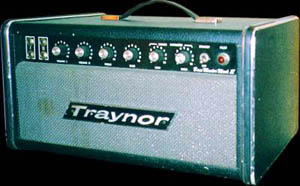
Features
Two channels (bass and guitar), two inputs for each channel, upper inputs are
slightly attenuated;
Treble and bass controls, a "tone expander" section with low and high knobs
(according to Dan Torres, these are actually midrange and presence controls);
there are two volume knobs that can be blended to get different sounds. One [channel] sounds kind of like a "bright" channel and one sounds regular
Two 6CA7/EL34 power tubes, three or four 12ax7s, solid state rectifier; hand
wired, very high quality work, simple easy-to-modify circuit; larger [than
the ones used in the Bass-Master YBA-1] 50-watt Hammond transformer (7 lbs.);
Often operated with 4 ohm loads; best used with an eight ohms cab
Runs on 540 volts, weights 54 pounds - bigger transformers [than the YBA-1]
Dimensions: 8"x18"x10" (HWD); weight: 40 lbs.?
Dimensions: 19"x13"x10"; weight: 54 lbs. (source: Catalog)
Early [Bass-Master] Mark IIs have the (noisy) fan mounted on the end [in the
cabinet side], later [Bass-Master] Mark IIs (with lift-off top, and the
reflector 'Traynor' logo) have it mounted in the back [center];
Silvery grey grille cloth;
Can exceed 600 volts on plate; expect about 550 volts, if you're lucky (one has
eported 537 volts on plate)
Early models are identical in appearance to the Voice Master/Signature.
I have swapped out the 4M volume pots for 1M, and put a 47K resistor in the NFB loop. These mods are worth doing to any Signature/Bass-Master, IMO.
Sound
Just like a plexi 50 watt Marshall (when used for guitar);
Punk or loud rock (or with channel bridging Entwistle's bass sound) (when used
for bass)
Better sound as a Fender Bassman (bass and guitar); lower powered, would work
just fine in a blues or lower volume setting (?)
loud as hell
class A circuit so there is little distortion, sounds very punchy and clear
very mechanical sounding; SRV and Hendrix heads need not apply. If you are
looking for something original sounding and with a good bit of style, this
is it (if you can find one)! More power and punch than Fender, less ruggedness
than Marshall. I'd say its closer to a Vox type sound, but if you want Vox
sound, this will not suffice.
Reliability
It's a risky proposition for repairs
Old and still going strong
Price
I bought my YBA-1A [used] about 15 years ago for $62 USD. [...] The 2nd [used] one I bought off ebay [for] $235 USD was totally moded for guitar with extra pots on the back [...]. [Oct 2002]
US $120 used; one can be bought for under [US] $200 - a total bargain
US $150 [used], needed a little work but playable, cheap buy
US $199 used, you can get one cheaper
CAD $300 [used], good condition, seen at Songbird Music, Ottawa, November 1998
(since January 1999 though, it had changed its condition to 'very good')
Rating
very good amp
My personal opinion is that the YBA-1 is better for guitar, while the YBA-1A is preferable for bass.
My YBA-1A [...] uses 6550s and it's the best rock bass head that I've owned. The 2nd one I bought [...] was totally moded for guitar with extra pots on the back and stock EL34s. I much prefer the 6550 head for bass.
I [...] have [an YBA-1A Mark II amp] that goes with [the YT-15 cabinet] and it's all sounds great.
i stuck a master volume on the back, jumped the channels, and cranked both channels to 7-8, plugged in my custom shop '61 reissue sg, and it kicks so much ass [through 4x12 25w greenbacks] its indescribable
i bought both a 1971 yba-1 and a 1972(?) yba-1a and really love them both. [...]
the yba-1a is currently beating the snot out of an old mesa 4x12 with 90 watters in it. it can be so loud i can't even describe it! it is truly addicting. i believe, though i am not sure, that these 1a's operate in class "a". this would make sense to me considering how very crushing it is and yet chimey.
typically playing a new gibson les paul "faded" through them.
A great amp. Bought it used for CAD $150. Put it to an old 18" cab and wow. Other than the old no ground power cord and serious shocks and buzz it sounded better than what i was using. The only real problem was it seemed to be blowing fuses. Even after a friend helped me switch the power supply to todays standards and no buzz and shocks occured. Still blowing fuses though not as often it seemed. I am told it may need some work on the tubes (cost about same as amp itself).
Rate the YBA-1A Bass-Master Mark II...
 1971 YBA-1A Bass-Master Mark II (top not removable despite later style case), front view, angle 1971 YBA-1A Bass-Master Mark II (top not removable despite later style case), front view, angle
 1971 YBA-1A Bass-Master Mark II (top not removable despite later style case), front view 1971 YBA-1A Bass-Master Mark II (top not removable despite later style case), front view
 1971 YBA-1A Bass-Master Mark II (top not removable despite later style case), back view 1971 YBA-1A Bass-Master Mark II (top not removable despite later style case), back view
 YBA-1A Bass-Master Mark II, catalog page YBA-1A Bass-Master Mark II, catalog page
 YBA-1A Bass-Master Mark II, schematic 1/1969-12/1970 YBA-1A Bass-Master Mark II, schematic 1/1969-12/1970
 YBA-1A Bass-Master Mark II, schematic 1/1969-12/1970 YBA-1A Bass-Master Mark II, schematic 1/1969-12/1970
 YBA-1A Bass-Master Mark II, catalog pages, manual, fan conversion, schematic 1/1966, schematic 1/1969-1/1972, schematic 1972-2/1973 YBA-1A Bass-Master Mark II, catalog pages, manual, fan conversion, schematic 1/1966, schematic 1/1969-1/1972, schematic 1972-2/1973
 YBA-1A Bass-Master Mark II: Looks to be the same as the other one with a choke except it shows 6CA7 as the power tube instead of 7027 (Larry). YBA-1A Bass-Master Mark II: Looks to be the same as the other one with a choke except it shows 6CA7 as the power tube instead of 7027 (Larry).
(Aaron,
Craig,
Dan Kukkonen,
Dan Lear,
Eric Knudsen,
Greg,
Jay Rogers,
John,
Jon Aley,
Kraig Olmstead,
Laws from Lawsstudio Canada,
Moon Keith,
Tim Baier,
vivaAnalog at www.lynx.bc.ca/~jc,
www.schematicheaven.com)
|
|
|

|
YBA-2 Bass-Mate
15 watts,
tube head and 1x15" tube combo,
before 1970?
|
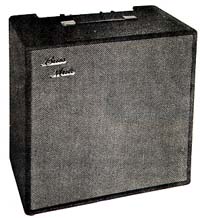
Features
volume and tone controls only; it has two inputs, seems to be high and low, no major difference
Two 6V6 power tubes
This one is a '67 [amp] and is in amazing shape. It uses an RSC (Radio Supply Corporation?) speaker that looks identical to the 15" Jenson in my '64 Fender Vibroverb. I had heard that the two companies had a deal back in the '60's - maybe this confirms it.
There's also a late version with 6BQ5 tubes. The serial number of such a amp head is 1091764 (indicating September 1971), the logo is of the parallelogram style but without raised letters. They are simply printed in white on a black metal strip. The name and model numbers are written using an italic style font on the identification plate and in a regular font on the front panel. Features needle style dials.
silvery grey grille cloth
The [combo] cab is more cube-like [compared to a YBA-2B]. There is also a square opening in the back whereas the later models [e. g. YBA-2B] were sealed back units.
Sound
This amp sounds great. With the volume control from 1 to 3, there is little difference in tone, but gives a nice clean sound from my stock 89 American strat. Turn it up past 3 and the power tubes start to overload as you increase the volume. With my guitar volume on 10 and the amp all the way up you get the most beautiful natural distortion for lead. By
backing off on the volume pot it cleans it up just enough for chords. The tone control seems to add more top end from 1 to 4, but from there on there is no major difference, but with both on full lookout, cause Clapton may knock on your door and wonder if Stevie Ray did pass away, or is just hiding out in your closet.
Great sounding amp. It has that grind everybody loves.
I played a YBA-2 Bassmate that someone converted to EL34s (poor tranny!) It was ravaged, and severely overpriced, but sounded fairly good.
Reliability
a few problems in the begining (tubes, hum), but everything is o.k. now
Price
YBA-2? Bass-Mate, US $199.99 used, good condition, seen at Daddy's Junky Music
at www.ugbm.com/amp.htm, September 1998
With the one possible exception of the Dyna-Bass, my 6V6/1x15 version of the YBA-2 was potentially the hardest to find in good condition.
I had been looking for one for years, and even though I live in Toronto, I had never seen one. I own about three or more of most other Traynor amp models, and I can attest that the 6V6 [YBA-2] Bassmate is potentially the hardest Traynor amp to find. [It was only made for a couple of years.] I seem to see the 6BQ5 version every couple of months. [March 2001]
Rating
This is the best practise amp you could ever want
[The 6V6 YBA-2 combo is] a hugely cool amp. One of the most "tres cool" and best sounding Traynor amps.
The YBA-2 combo is one of the coolest Traynors. I'm a huge fan of the YBA2/YBA2B amps,
and try to use it as often as I can.
I love that [YBA-2] 6V6 head. It sounds great through a Leslie model 16! Great "Blind Faith" tones.
Rate the YBA-2 Bass-Mate...
 YBA-2 Bass-Mate, front view, angle YBA-2 Bass-Mate, front view, angle
 YBA Bass-Mate series, catalog page YBA Bass-Mate series, catalog page
 YBA-2 Bass-Mate, front YBA-2 Bass-Mate, front
 YBA-2 Bass-Mate, back YBA-2 Bass-Mate, back
 YBA-2 Bass-Mate, speaker YBA-2 Bass-Mate, speaker
 YBA-2 Bass-Mate, control panel YBA-2 Bass-Mate, control panel
 YBA-2 Bass-Mate, control panel YBA-2 Bass-Mate, control panel
 YBA-2 Bass-Mate, logo YBA-2 Bass-Mate, logo
 YBA-2 Bass-Mate, tube layout YBA-2 Bass-Mate, tube layout
 YBA-2 Bass-Mate, serial plate YBA-2 Bass-Mate, serial plate
 YBA-2 Bass-Mate, 12" speaker. [Bought] from a guy who claimed to have been a keyboard player from CROWBAR. He claims that he was in the basement of Yorkville with Pete when Pete made this amp FOR HIMSELF. Guy said “See, there was NEVER a logo on it.” Though there are some conspicuous snags in the grill cloth in the upper left corner. YBA-2 Bass-Mate, 12" speaker. [Bought] from a guy who claimed to have been a keyboard player from CROWBAR. He claims that he was in the basement of Yorkville with Pete when Pete made this amp FOR HIMSELF. Guy said “See, there was NEVER a logo on it.” Though there are some conspicuous snags in the grill cloth in the upper left corner.
 YBA-2 Bass-Mate, 12" speaker. Guy also said; “Note there NEVER was a serial number plate on the back.”, And that does stand up. I also note the corners protectors look like those on the Dyna Bass S/N 0011. YBA-2 Bass-Mate, 12" speaker. Guy also said; “Note there NEVER was a serial number plate on the back.”, And that does stand up. I also note the corners protectors look like those on the Dyna Bass S/N 0011.
 YBA-2 Bass-Mate, 12" speaker. [...] [T]he amp featuring a 12” speaker (non-original Celestion) the controls are at bottom back, NOT back top as were the production amps. (Gerry) YBA-2 Bass-Mate, 12" speaker. [...] [T]he amp featuring a 12” speaker (non-original Celestion) the controls are at bottom back, NOT back top as were the production amps. (Gerry)
 YBA-2 Bass-Mate, schematic 2/1967 YBA-2 Bass-Mate, schematic 2/1967
 YBA-2B Bass-Mate manual, YBA-2A Bass-Mate schematic 11/1966, YBA-2A/B Bass-Mate schematic 1/1969, YBA-2A/B Bass-Mate schematic 11/1970-11/1976 YBA-2B Bass-Mate manual, YBA-2A Bass-Mate schematic 11/1966, YBA-2A/B Bass-Mate schematic 1/1969, YBA-2A/B Bass-Mate schematic 11/1970-11/1976
(Brent Romanuk,
Craig,
Dan Lear,
Dennis Royl,
Eric Knudsen,
Mike Levy,
Moon Keith,
Tim Casey,
www.schematicheaven.com,
yorkville.com)
|
|
|

|
YBA-2A Bass-Mate
25 watts?,
tube head,
1970
|
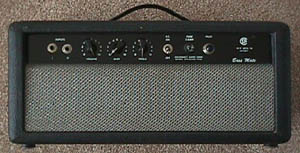
Features
There are two versions, one has two 12AX7 tubes into two 6V6 output tubes, the other has [two?] 12AX7 tubes feeding a quartet of EL84 (6BQ5) output tubes.
[1972?] YBA-2A Base-Mate head. S/N NB-6100. This unit uses 6V6 output tubes.
original Sylvania 6V6GT tubes in the 6V6 version, original Phillips-Mullard tubes in the EL84/6BQ5 version
[1971, EL84/6BQ5, original Phillips-Mullard] The tube chart was rubbed out where it indicated the 6V6's - I really wish this one had 6V6's - and in its place 6BQ5 was written in pen. I believe the logo is one of the last block logo types (just before the parallelogram was used). The logo looks almost like the 60's ones, but it is slightly different, and is made out of plastic, not metal.
It has two inputs.
silvery grey grille cloth
Dimensions: 16 1/2 " x 9 3/4" x 8 1/4"; weight: 22 lbs.
Sound
gets a very Vox-ey grind when pushed; the old version Bass-Mate is as close to
a small-box 50 watts Marshall as I've ever heard.
It sounds marvelous as a bass amp when played at medium levels and breaks up when cranked. [With guitar it has a] great natural tube distortion.
This little puppy oozes 6V6 tone. The lows and mids are thicker and more pronounced than my EL-84 powered YBA-2A head. The power is about the same. The distortion sounds like a Marshall-Fender cross, whereas the one with EL-84's is more Voxy. I can't wait to run this
into some proper speakers. I tested it into a 2 x 12 Marshall cab, but I have an early 1960's Johnson cab w/ original Celestion alnico G-12's in storage... I think I just may find tone heaven!!!
Just got the YBA-2A yesterday, the 6V6 model. Blue jewel light looks nice, don't know if it's original. Original Sylvania 6V6GT tubes looked about dead, but the amp still sounded OK. I swapped in a pair of very old Weber 6V6GT (could be RCA rebrands) that appear to have some life left. Also swapped a Valco (?) 12AX7 in the first socket (the originals look pretty worn). The amp sounds a bit better now, and WHAT A SOUND it is! Too good
to discuss... [...] Newer tubes may improve it even more.
Does it keep up tonally to a YBA-1 Bass-Master? Unfortunately not, BUT these little amps certainly have a charm of their own!
Reliability
-
Price
YBA-2A Bass-Mate, CAD $175 [used], seen at Gilles Grignon's site at Rainbow
Music at www.rainbowmusicshop.com/used.html, January 1999
About US $100 at an auction at Ebay, three days to go. Scratchy pots, missing back wood cover. March 1, 2001
1971 YBA-2A with original Phillips-Mullard EL84/6BQ5 tubes, bought in a pawn shop, March 2001, very reasonable price of $140 CAD.
I recently acquired a YBA-2A head from some poor ignorant soul's garbage. It was loaded w/ 6V6's upon inspection and when I re-tubed it and biased it I was astounded by it's fabulous tone.
August 1971 YBA-2A (EL84 tubes) in great shape, tolex, grill, everything, works fine, sold on Ebay for US $228, May? 2002
Rating
for the money, I'll take 'em any day
[The 6V6 YBA-2A is] a great amp, especially since you have [both, the 6V6 and] the EL84 version. The two of them are tone landmarks (in disguise).
Rate the YBA-2A Bass-Mate...
 YBA-2A Bass-Mate, front view YBA-2A Bass-Mate, front view
 YBA Bass-Mate series, catalog page YBA Bass-Mate series, catalog page
 YBA-2A Bass-Mate, catalog page YBA-2A Bass-Mate, catalog page
 YBA-2B Bass-Mate manual, YBA-2A Bass-Mate schematic 11/1966, YBA-2A/B Bass-Mate schematic 1/1969, YBA-2A/B Bass-Mate schematic 11/1970-11/1976 YBA-2B Bass-Mate manual, YBA-2A Bass-Mate schematic 11/1966, YBA-2A/B Bass-Mate schematic 1/1969, YBA-2A/B Bass-Mate schematic 11/1970-11/1976
(CW,
Dan Lear,
Ebay,
Edde,
Glen H.,
Jason Macaulay,
JC,
Moon Keith,
Patrick Walsh,
Tim Casey,
vivaAnalog at www.lynx.bc.ca/~jc,
www.schematicheaven.com)
|
|
|

|
YBA-2B Bass-Mate
15 watts,
1x15" tube combo,
1970
|
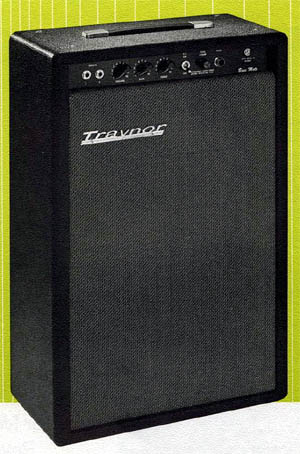
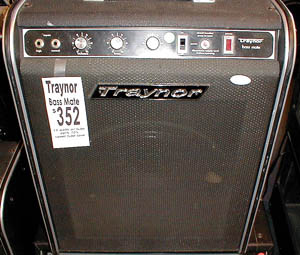
Features
bass, treble and volume controls. A glance at the schematics shows that the
volume control is not a regular gain type volume that is found on most amps,
rather has a resistor in that position, with the amp 'dimed' and the volume
control that is on the amp is actually a master volume;
There's a early version with two 6V6 tubes. The serial number of such a combo is 31453, there presently is no logo on this particular amp but I seem to recall that it had a partial (broken) script logo when I first got it. The name and model numbers are written using an italic style font on the identification plate and the front panel. Features ordinary round dials.
about 15 watts (two 12AX7s, two 6BQ5s (EL84)). To get a better tone, for guitar at
least, a few minor mods can be made quite easily, especially since this amp is
all point to point wired!
A 1971 YBA-2B Bass Mate 1x15" combo is the EL84 version, not the sought-after 6V6 version. It doesn't have the chrome "bumpers" like some of the later ones I've seen.
front panel has high and normal inputs, volume, treble and bass controls with
a 1 amp[ere] fuse and an on/off switch; rear panel has an 8 ohm speaker socket;
four tubes: Two EL84/6BQ5 and two 12AX7 tubes
Traynor made both the 6V6 and EL84/6BQ5 based YBA-2A/B amps in the mid to late sixties. Both these amps were cathode biased. Tonally 6V6s are a creamier sounding tube and the 6BQ5s are more glassy. I personally think both of these amps had a nice round sound and got pretty crunchy when pushed. My personal preference for the 6V6 version is largely based on the fact that I have always loved the sound of these tubes. Your tastes might be different.
In the seventies, Traynor only made the EL84/6BQ5 version and the design switched over to fixed bias. There were other circuit variations, but this was the biggie.
This tone and feel of the amps from the two decades are different.
To switch a seventies version over to cathode bias would be simple. To change output tube types would be painful. EL84s/6BQ5s are small 9 pin tubes and 6V6s are octal tubes. You would have to resocket the amp, which means punching holes in the chassis.
silvery grey grille cloth
closed-back combo
Dimensions: 27 1/4 " x 16 1/2" x 9 3/4"; weight: 42 lbs.
Sound
gets a very Vox-ey grind when pushed; the old version [e. g. 6V6?] Bass-Mate is as close to a small-box 50 watts Marshall as I've ever heard
many tones possible, very clean, tons of headroom (for guitar and bass)
[The YBA-2B combo] needs no help to get the kind of growl that many other amps need an array of pedals to obtain. But by far the sweetest sounds are obtained with my Am. Std. Tele, followed closely by the Les Paul.
I've got the [EL84] YBA-2B combo, and it's got a shamefully vibey grind, distinct but familiar. I'm nuts about it, and have been looking for the 6V6 version for a few years. They seem a bit harder to find.
[An EL84 YBA-2B Bass-Mate] sounds absolutely fantastic! [...] It is rated at 25 watts but sounds more like a 100 watt killer tube amp with monster tone.
I personally prefer the sound of this [6V6] amp over every amp in my home from the JCM 800 Marshalls, Fenders, every other Traynor and even my early Ampg Reverborocket. It is simply an awsome amplifier.
Based on my experience, the YBA-2B won't be loud enough to pair with a Fender Super, it barely keeps up with my Deluxe Reverb.
My YBA-2A head with EL84/6BQ5 tubes is significantly newer and cleaner than the YBA-2B, [but] it lacks that balsy sound that the combo [6V6 or EL84?] puts out. Yet, I do prefer it to my all my various YGM-3 models.
I appreciate the clean headroom, and the [EL84] amp does seem to break up nicely, but only past "7" or so on the volume dial.
It's a fabulous amp, and should get you very close to the Thunderbolt tones (assuming Page
is your reference point).
I find the Bass-Mate to be a little too bottom heavy (surprise, surprise - it's a bass amp, after all) and lacking in highs for my needs. I could see how it would make a killer match for a Telecaster as-is, but I need a little more sparkle for the hollowbodies.
Reliability
very solid
Price
US $50 used
YBA-2[B] Bass-Mate in pretty good condition. It's got a pair or 6V6s (RCA no less) and a speaker in a sealed back cab. A pawn shop had it tagged at US $190, March 1999
'a guy in Massachusetts' was asking US $165 for a YBA-2B Bass-Mate including shipping [to Canada?], March 1999
70's YBA-2B Bass-Mate combo, CAD $350, October 2001, offered on the web-site of Songbird Ottawa
I happened to win this amp from my bass player in a poker game.
YBA-2B, eBay auction, sold for US $134 , March 2002
[On the same eBay auction] 'Buy it now' for [US] $250? Is it just me or is this [person] something of a dreamer?
Rating
decent guitar amp
Of all my Traynor, Marshall Fender and other amps, the YBA-2B [6V6] combo is by far the
favourite in our home. I have experimented using my YBA-2 head and some of my YGM-3s on the YBA-2b's speaker and they simply do not have that balsy, Page sound.
Every other amp is typically used with an arsenal of Boss pedals. But this baby puts out its own unique effect. It has to be the 6V6s. Truly exceptional in my opinion.
1969 YBA-2B with 6V6 tubes: Purchased in Hamilton, Ontario. Looks like Its been modded a bit. Extra hole in the chassis. Dated to '69 by styling and tubes (from Traynor's history page). YBA-2B only used 6V6 tubes for a short time in 1969. Has original "rayno" logo. Black tolex covering with metal corners. No aluminium trim. [...] Currently running with new JJ 6V6 and Sovtek 12AX7. Sounds AMAZING with my tele. I wish it was as loud as my Hot Rod Deluxe.
Rate the YBA-2B Bass-Mate...
 YBA-2B? Bass-Mate; old style, Fender-type wrap-around case, front view YBA-2B? Bass-Mate; old style, Fender-type wrap-around case, front view
 YBA-2B? Bass-Mate, front view YBA-2B? Bass-Mate, front view
 YBA Bass-Mate series, catalog page YBA Bass-Mate series, catalog page
 YBA-2B Bass-Mate, catalog page YBA-2B Bass-Mate, catalog page
 1969 YBA-2B 6V6 Bass-Mate, front 1969 YBA-2B 6V6 Bass-Mate, front
 1969 YBA-2B 6V6 Bass-Mate, front close 1969 YBA-2B 6V6 Bass-Mate, front close
 1969 YBA-2B 6V6 Bass-Mate, wiring 1969 YBA-2B 6V6 Bass-Mate, wiring
 YBA-2B Bass-Mate manual, YBA-2A Bass-Mate schematic 11/1966, YBA-2A/B Bass-Mate schematic 1/1969, YBA-2A/B Bass-Mate schematic 11/1970-11/1976 YBA-2B Bass-Mate manual, YBA-2A Bass-Mate schematic 11/1966, YBA-2A/B Bass-Mate schematic 1/1969, YBA-2A/B Bass-Mate schematic 11/1970-11/1976
(Craig,
Dan Lear,
Dennis Royl,
Edde,
Gino Iorfida,
Kevin Taylor,
KO,
Lee MacMillan,
Moon Keith,
Nigel Stanley,
Tom Becker,
Tim Casey,
vivaAnalog at www.lynx.bc.ca/~jc,
Wayne,
www.schematicheaven.com)
|
|
|

|
YBA-3 Custom Special
105-160 watts,
tube head,
ca. 1966/7 1972?
|
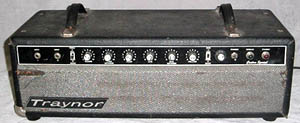
Features
one channel and two inputs; volume, bright, treble, treble expander, bass, bass
expander, bright switch, deep switch, stand-by switch, pilot light for stand-by and
operate.
This amp was built to play larger halls and outdoor concerts. The lack of reverb was not a big issue as most live performances had acoustics full of reverberation (halls, arenas).
on rear you have speaker jacks and power [jack/switch], ground switch, ac outlet fuse, no impedance selector
This Canadian-made head dates to before 1969, when Traynor added a master volume control. Peter Traynor built these things to stand up to road abuse, unlike a lot of vintage stuff. It sounds great with either bass and guitar, providing a clean (and loud) tone. Works great in large club settings. Front panel has two input jacks, controls for treble boost, volume, treble expander, treble, bass expander, bass, presence, and bass boost. There is also a standby switch and corresponding green and red pilot lights. The back panel has one on/off switch, one ground switch, output jacks for a speaker and an extension and an outlet for a two-pronged plug. There are no effects in this head, but stomp boxes work just fine. The front of the amp is wrapped in a Fender-style silver-face cloth [...]. There is also a cooling fan installed.
original tube complement: Three 7025As and four 7027As or three 12AX7s and four 6CA7s or (early models) 7027 tubes; also used (late version): Four EL34s
I have rewired the amp to handle 6550s and added fuse protection for the B Plus voltage.
Many early Traynors have been converted [from 7027A] to 6CA7 tubes, on Yorkville's advice. Later YBA-3 amps came with 6CA7 tubes stock.
With 6550 tubes, you'll get about 200W from the Custom Special.
Original tube [complement] was three 12AX7s and four 6CA7s that I swapped for 6550s (very easy, just boost bias about ten volts in order to have 30ma idle) Original input resistor was 100k and I changed it for 5.6meg like my Ampeg.
Can be converted from 7027 to EL34, I think a pin jumper is needed. [...] Not a big deal.
fan cooled stock, because original tube setup run hot (running at 540 volts on plate);
big heavy Hammond transformers;
Performes best with a 4 ohm cabinet. The schematic for my '69 Custom Special says to use an 8 ohm load. However, if you take a look at Traynor's advertising from the period, they seem to recommend cabinet combinations which would result in loads as low as 2 ohms (as I recall... don't have the ads in front of me). My amp makes around 160 watts into an 8 ohm dummy load, and 120-140 into 4 ohms.
I have trouble with [the] suggestion that it produced 160 watts, however. I didn't have any way to measure it at that time, but Peter himself only claimed about 105, and 80 watts/pair is a lot to expect even from 7027s in the real world. I don't think switching to 6550s will make the transformers any hotter.
silvery grey grille cloth
dimensions: 8"x29"x10" (HWD); weight: 60 lbs.
This amp won't fit easily in the backseat of modern cars (forget the trunk, you'll need a van or a pick-up).
I have been playing bass guitar for almost 40 years. I have owned quite a few amps over the years (including a 72 SVT with both 8x10 cabs} and this Traynor yba-3 head is one of the best! It has great tone and plenty of volume. It is heavey but it's lighter than an SVT and less expensive. I own 3 of these heads and they are from 1968 and 69 non-master volume. The non-master volume heads have chokes in them. I have used JJ-E34L's, EH6550's and Svetlana KT88's in the heads that I own. The KT88's make a lot of power and sound better than the 6550's but the JJ-E34L's have the best tone. The low end and low mids are lush, very tubey. The tone cuts right through the band in a very full and pleasing way and fills any voids. I have the tubes biased at 30 ma. The only thing the head needed was more low end, every thing else was there. Almost all the bypass caps are .1 mfd 600volts except one that is .02 and it goes to either the bass control or the expander control. Change that .02 cap to a .1mfd 600volts. The last two caps at the phase inverter(bias feed) are .1 change these two caps to .33 or.47 mfd 600volts which ever ones are easier for you to get.
Ampeg had these on many amps. Also at this location are two 220k bias feed resistors
(or at least their should be) change the two 220k resistors to 100k resistors. This will help the tube deal with the high voltages. On EL34 tubes pin 1 is an active pin. It is tied to a grid.
On many amps pins 1+8 are tied together and are grounded to the chassis of the amp but Traynor amps use pin 1 as a second bias voltage feed (raw bias). Pin 5 sees normal bias voltage and if you look you'll see all of pin #1's looped together off the circuit board.
BIAS VOLTAGE IS NEGATIVE VOLTAGE THAT KEEPS THE POWER TUBES FROM OVER HEATING AND BURNING UP, IT KEEPS THE POWER TUBES STABLE. It takes the bias voltage from the right side of the circuit board and loops to every pin one and then goes back to the circuit board completing the circuit. When the amp is in the standby mode it sees about 100 volts of bias. When you turn the amp on the bias voltage comes down slowly, takes about 60 seconds. This way the tubes are protected from the surge of dc power going to the power tubes. The amp will sound fuzzy and distorted until the bias voltage fully drops. So you have bias voltage on pins 5 and 1 . This is how Peter Traynor wanted it. It makes the amp cleaner and more stable.
***** Also note that if you use 6550's or Kt88's pin 1 on these tubes is connected to the metal collar so if you put these tubes in this amp you will read bias voltage on the metal base of the tube. If you want to use THESE tubes I would disconnect the bias voltage going to pin 1 and recheck that you are still seeing bias voltage on pin 5 !
I bought a YBA-3 new in '68 with 2- 4X12 huge open back cabs for 1400.00 to replace a Standell amp I had. The ad I saw before purchase stated it was rated at 320 watts!! I think the cabs had Goodman speakers. The cabs had a removable dolly boards and the amp had a "T" bolt to secure it to one of the cabs. If you see one of these cabs that's the reason for the threaded insert on top. These were the day's when bigger was "far out". They also had a smaller closed back version with what I was told were Norelco? speakers. Pete had a good thing goin for him. They also had a 6?x10 version for the Bass guys. Ampeg 8X10 coffins came out later.
The amp would stay clean at full throttle. I used a Silvertone 1482 as a preamp set up on top the amp with a dummy 8 ohm resistor, and resistors in series to drop the output signal voltage to around .6 volts. I'm 5''6" it was all I could do to reach the preamp for adjustment. A lot of guys were doin' similar things to get crunch out of Twins etc. It was freakin' awesome, and a Marshall killer. I had the Traynor checked by a tech after an intermittent transformer problem. With a new transformer it didn't clip till 98 watts. I used this set-up till the early 90's. The amp disappeared after a show one night and I was heart broken. I still have the Silvertone.
I will say the only thing that I could find to duplicate the sheer power of the Traynor was a Rivera M-100 which I bought as a replacement and still have in my collection.
Nothing topped the YBA-3 amp for clean power and tone for days. I still remember the photo of Pete tossin' the amp to prove its reliabilty. Clean out the broken tubes, re-tube it and play on. Most of the plastic logo's broke off of these amps and cabs so it wasn't unusual to see "raynor's", "Trayno" or "rayno" logos swinging when you moved them.
I say so long to a very reliable and good friend. It shared a lot of great memories with me. (Jeff J. De Roche)
Sound
sound is solid and clean; if you need distortion you'll have to add it with a
pedal; I play hard rock;
The sound is loud clean and fat, and can compete easily with any today bass amp reference especialy plugged into SVT 8-10 cab. This is especially true with this mod [e. g. 6550 tubes]. This is a clean bass amp but my guitar player was surprised to like the sound of his Stratocaster through this amp because it sounded tubey (à la Fender).
better sound as a Fender Bassman (bass and guitar); will work just fine in a
loud rock setting;
more versatile than the Bass-Masters
I always used it for bass. It's more power than any right thinking guitarist would ever want. It's pretty damned loud. Don't expect to be getting power tube distortion out of it - it's made to be a bass amp. I never modded it because it was perfect for my needs as is. Mine was a 1973, with the master volume, EL-34s and the ulta-snazzy red (in standby) and green (not in standby) power lights... it was a great amp, [...] I think of them as 2/3 of an Ampeg SVT... in a lot of ways, including weight.
Using it for bass and the YBA-1 for guitar is a great idea. It plays bass with much more authority than the Bass-Master. Go for it.
Although designed for bass, the amp was very handy when extra volume was required. This is not an amplifier for your living room or basement jam sessions. The amp fit the bill for a power trio when you needed to fill the hall. If you are wanting to recreate some of the mid to late sixties power trio experience, this amp will do it. Mostly I played a Gibson EB-0 bass or a Fender Stratocaster. With bass I would get by with Traynor's "Big B" YC-810 Bottom (8x10" speakers) and for guitar I would add another 2x15" bottom. When that wasn't enough I would throw in two 15" horns. This amp works best with Gibson basses and Fender guitars. The reverse combination does not work as well.
I had one of these when they were new (serial number about 17), and basically found it too loud and hard to distort for my style. Eventually traded [it] for a 1968 Bass-Master.
The sound is solid and clean. If you need distortion you'll have to add it with a pedal.
Very heavy but what a great sound!
Big and Loud.
I have an YBA-3 with 8x10s in the cabinet. With dolly. Sounds great, have used for both guitar & bass. It will make your neighbors think the end of the world is at hand.
Reliability
this amp used to be totally reliable
To gig I bring this amp and a Ampeg V4B but I could use it alone it never broke down. Wiring is like old Fender, road proof, schematic is stick on chassis cover so you can have service in any shop.
old and still going strong
My son's alterna-punk band has used this setup [e. g. a 4 Ohm load] for bass at several gigs, wide open and definitely driven into clipping all night long. The tube plates have never shown any red, and the transformers barely even get warm to the touch. It's a brute
of an amp, in other words, and I have no hesitation in operating it into 4 ohms.
This is the kind of amp you could throw in the van and boogie.
This amp used to be totally reliable. It never let me down. However after thirty plus years (circa 1966), I am changing the caps and making minor modifications such as adding a bias pot. You can push the limits with this amp and then get it fixed to start over again. This isn't an amplifier for bassists/guitarist with an easy touch. If you are interested in owning this amplifier, you'll need to find a technician first or be a techy yourself. Handy with a soldering iron just won't cut it.
Price
CAD $300 used [October 1997]
CAD $200 used [October 1997]
US $275 [used], needed a little work but playable, cheap buy
US $279 [used], seen at www.brocktonmusic.com/amps.html, September 1998
CAD $395 [used], not a bargain, bought at www.songbirdmusic.com, most
recently [October 1998]
US $275 used, plus shipping, very good condition, early model, seen at the
Harmony Central classifieds, November 1998
CAD $353 [used], early 1970s, good condition, seen at
http://www.songbirdmusic.com, February 1999;
This same amp changed apparently its price to CAD $305 in April 1999
YBA-3, early model without the side rails, in good working condition and has not been modified, [US?] $300, on the Traynor mailing-list [May 2000]
YBA-3, good condition, needs cleaned up, [US] $100 firm, seen advertised on www.compufind.com [June 2000]
Bought a 1968 YBA-3 (serial# CS2318) that worked, [it just] needed its pots cleaned, had some small scratches on its bottom, for [US] $100 plus shipping and that should be about US $50 more [April 2001]
I paid (and got back out when I sold) [CAD?] $275 - $300 for that amp. If it's as good as mine was, it's well worth $300. Snap it up. [April 2001]
1969? YBA-3 (serial number CS-1293), bought on eBay for [US?] $45! Great Buy! [October 2001]
Rating
I would buy it without question. I love its extra power and great tube sound. This baby delivers.
If I find another one I buy it [...] very practical amp.
I've owned the YBA-3 - it was a fabulous amp.
I have a [1976] YBA-3 which I bought matched with a [1976] Traynor Group 3 4x12 cabinet. [...] I've been running this rig for about five months now on live gigs. It's wonderful... all the power I'll ever need. Size and weight are an issue. With the Group 3 cab, it stands about five and a half feet tall and must weigh 160 lbs. The EQ capabilities are great and with the channel/master volume combination, I can get it to crunch pretty well. Certainly my favourite amp in thirty years of playing... but then I've never owned an SVT.
Rate the YBA-3 Custom Special...
 YBA-3 Custom Special, (old style, Fender-type wrap-around case; old
logo), front view, angle (on top of a Voice Master) YBA-3 Custom Special, (old style, Fender-type wrap-around case; old
logo), front view, angle (on top of a Voice Master)
 1973 YBA-3 Custom Special (removable top; with master volume), front view 1973 YBA-3 Custom Special (removable top; with master volume), front view
 1973 YBA-3 Custom Special (removable top; with master volume), back view 1973 YBA-3 Custom Special (removable top; with master volume), back view
 YBA-3 Custom Special and YC-810 "Big B" speaker cabinet, front view, angle YBA-3 Custom Special and YC-810 "Big B" speaker cabinet, front view, angle
 YBA-3 Custom Special, front view YBA-3 Custom Special, front view
 YBA-3 Custom Special, back view YBA-3 Custom Special, back view
 YBA-3 Custom Special, front view, angle YBA-3 Custom Special, front view, angle
 YBA-3 Custom Special, schematic 1/1967-10/1972 YBA-3 Custom Special, schematic 1/1967-10/1972
 YBA-3 Custom Special, schematic 1/1967-10/1972 YBA-3 Custom Special, schematic 1/1967-10/1972
 YBA-3 Custom Special, schematic 1/1967-10/1972 YBA-3 Custom Special, schematic 1/1967-10/1972
 YBA-3 Custom Special, manual, schematic, schematic 1/1967-1970, schematic 1/1967-4/1974 YBA-3 Custom Special, manual, schematic, schematic 1/1967-1970, schematic 1/1967-4/1974
(COOL SCHEMATICS at http://www.mif.pg.gda.pl/homepages/tom/schematics.htm,
Dan Lear,
Dave,
Dave,
Eric Knudsen,
Gary,
Glen H.,
Gord,
Ian Craig,
John Shedlock,
Kerry Ayres,
Kraig Olmstead,
Michael E. Levy,
ocd3py,
Os,
Robert De La Cruz,
Stevie Rob,
Terry Ladd,
thewrath2,
vivaAnalog at www.lynx.bc.ca/~jc,
www.schematicheaven.com,
www.songbirdmusic.com)
|
|
|

|
YBA-3A Super Custom Special
250 watts,
tube head?,
1967
|
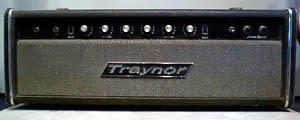
Features
It looks like an early YBA-3 with a Fender type wrap around case. I think my amp is very early - from the first production run - perhaps '67 or '68. It has no serial number, and the revision block on the schematic is empty. There pencilled in corrections on the schematic that look factory original.
two input single channel with master volume; tone controls consist of bass and treble boost switches, bass gain and bass expander, treble gain and treble expander.
Uses three 12AX7As, runs a quartet of EL509s (6KG6As) at 560 Volts (or 630 volts as in a 1968 amp) to produce an insane quantity of house shaking power (probably capable of about 300 watts - it'll do 150 without clipping into a 2 ohm dummy with only two EL509s in the chassis)
Actually, 6KG6A tubes are easy to find - even Electro Sonic lists them in their current catalog. Svetlana is currently making an expensive version. I have ordered NOS US tubes from AES (tubesandmore.com) to save about $10 a tube. [June 1999]
I'd be a little wary or the [YBA-]3A - it uses bizarre tubes and I'm not sure how plentiful they are. It didn't use a standard amp tube - it was something much weirder.
The tubes are obscure - and they use strange sockets, which makes changing tube types a lot of work. The YBA-3A uses four 6KG6A (AKA EL509, EL519) beam tetrodes (same general type as 6550s and 6L6s). However, it uses a nine pin magnoval socket and a cap on top for the plate connection. It has a glass base - the pins come directly out of the glass like a gigantic 12AX7.
On the plus side, while there are not many of the tubes around, no one wants them, so if you can find them they are cheap. I bought four RCA NOS 6KG6A/EL519 for about $15 US each from AES a year ago. (They are in current production at Svetlana tec-sol.com/products/tubes/svetlana/el509.pdf). The new Svetlana EL509/6KG6 tubes are supposed to be very high quality - but more expensive than the NOS RCA's. (I checked again today - the Svetlana tubes are now $32 - up about $10, and the NOS tubes are $22, up about $7 - ouch). [June 2000]
it has two speaker output jacks and a switch for 2 or 4 Ohms
silvery grey grille cloth
Sound
With my 66 Jazz and a Yamaha 2x15 cabinet it is a very warm sounding amp - actually leaning toward the muddy side. I haven't gigged with it yet as it is still on the bench.
Reliability
When repaired and set up properly this should be a fairly reliable amp as old tube amps go. The EL509s seem to run pretty cool and should provide very good service life. The problem is getting good output tubes for it - EL509s aren't all that common and are hard to find matched. I don't recommend the Sovtek 6pi45C, I bought some (unmatched) and two were trash - they failed quite spectacularly. I highly recommend adding some output fusing.
Price
US $50 used [before February 1998]
US $90 used, amp in very good (8/10) condition, 1997
YBA-3As are rare indeed. [June 1999]
Rating
This is a very cool amp, I've never seen another one like it. It's freakin huge. This is one of those amps you take to gigs just to scare the competition - when you drag this bad boy out of the truck (you couldn't get it in a car) they will know you ain't screwin' around. It should have been called they Traynor Peterbuilt.
Rate the YBA-3A Super Custom Special...
 YBA-3A Super Custom Special, front view YBA-3A Super Custom Special, front view
 YBA-3A Super Custom Special, front view, angle YBA-3A Super Custom Special, front view, angle
 YBA-3A Super Custom Special, instructions YBA-3A Super Custom Special, instructions
 YBA-3A Super Custom Special, schematic YBA-3A Super Custom Special, schematic
 YBA-3A Super Custom Special, two manuals, two schematics YBA-3A Super Custom Special, two manuals, two schematics
(basspalace.com,
Chris Oswald,
Dan Lear,
John,
Eric Knudsen,
Kraig O,
Mike Holman,
Paul Bechtoldt,
Steve,
www.schematicheaven.com)
|
|
|

|
YBA-4 Tube-Bass
50 watts,
1x15" tube combo,
before 1978
|
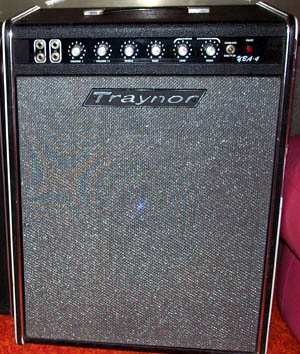
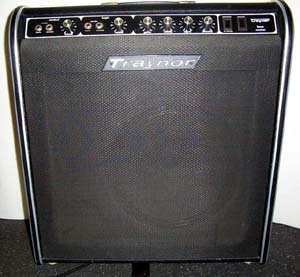
Features
The schematic [of this 1977 YBA-4] is somewhat like the 1972 YBA-1 schematic,
however there are some significant differences. The presence control is moved
back in between the 2nd and 3rd gain stages. Most different is the power supply.
The HV winding is now untapped, a 4 diode bridge is used for rectification, and
there is no seperate bias winding. Bias voltage is taken off the main HV winding
by means of a .047uf capacitor. Due to the untapped winding, no bias voltage is
produced until the standby switch is on, producing a short delay until full bias
is achieved.
The chassis is the same as the YBA-1 of the same year, except no accessory outlet, 1 1/4 inch external speaker jack, and internal speaker connects via a RCA phono plug on the bottom of the chassis.
The cabinet holds one 15 inch speaker, unmarked, shiny frame, large square magnet. The cabinet is vented by two ports in front. Grille [cloth] is dark black [or silvery grey?],
removable by velcro retainers. Sides are trimmed in automotive type silver and black side molding.
Unlike earlier YBA-1, this unit has a rather skimpy output transformer and no
choke. Tube complement is two 6CA7 and three 12AX7A. The amp still has the
original Phillips/Mullard EL34 output tubes in it, and three GE of Canada, made in
Japan 12AX7A tubes. Circuit contruction is eyelet on tan paper/phenolic board.
Filter caps were mounted inside the chassis with side clamps.
[Although power output is 50 watts nominal, it is] probably more like 40 watts
clean.
it runs on a duet of EL34s - somewhere around 50watts... the preamp is voiced for a bluesy feel which means that it has a medium amount of headroom... preamp headroom in almost all guitar tube amps is set by the two resistors in the filter circuit - these can be lowered somewhat to provide more preamp headroom and an overall cleaner amp sound... I can very easily see this amp used for playing jazz - it has a smokey feel to it, a little bit like the Ampeg Gemini's but not as opaque... besides, Mike Gauthier in montreal plays his Guild Artist Award through a Marshall Bluesbreaker combo which is basically the same circuit since the JTM45 based Marshalls and the Traynor Bassmate YBA-4 and Bass Master YBA-1/1A are
all based on the famed Fender 5f6-A/5f8-A Tweed Bassman/Twin ('58/'59) topology we all know...
sealed cab, a 1973 amp has rubber bumpers
Sound
... I was in the back seat of this limo recently... and some lady brought over her Traynor YBA-4 [Bass-Master] [...] to my shack for a tune up... somebody had erroneously stuck some 6L6's in there and one tube was weeny roasting... but the amp was otherwise stock... anyway, after replacing these by used NOS EL34s this thing spat out tremendous tone and attitude - it's almost as if Rory Gallagher had come for a visit... yes, I was blown away by this Traynor and somehow it took an extra week of full out testing before the lady got her cute little combo amp back...
[1973 YBA-4 Bass-Master] sounds awesome with my Les Paul. It's an YBA-1 head in the combo version, but to me it has a nicer tonal quality than most of the YBA-1s I've played. I'm can't explain why, the heads have been hooked up to various cabs, but none as pleasing as the combo. I also tried it through my YT-15 cab... didn't like it... sold the cab.
It could work very well as a jazz amp, but you need to try it out with your guitar - the tone controls have limited flexibility - you would have to see if you can get the sound you want.
the 1x15" closed back bottom of the yba4 is simple and effective... the amp has a gutsy feel to it (voiced like a Traynor, not sounding like a JTM45 or '59 Bassman) and the speaker is there with it all the time - no frapping... as for jazz, I sure wish I'd hear more players ridding on this smokey stuff... John Scofield take note!
Reliability
-
Price
CAD $400 [used], good condition, seen at www.songbirdmusic.com, April
1999
pretty cheap
YBA-4 Bass-Master, eBay auction, it's about to sell for [US?] $150, which is pretty darn cheap. I was dying for one of these amps a few years ago. Subsequent Traynor (and other amp) purchases have made it nearly impossible for me to justify even at this price. Bummer. Whoever gets it is getting a nice amp for dirt cheap. It's gonna sell in about 4 minutes [April 2001]
YBA-4 Bass-Master, seen for sale at Harmony Central, US $225 [May 2000]
Rating
The speaker cabinet though carefully sealed and ported appears to have had no
particular design as to its volume or porting. As a result, it is a really poor
sounding bass amp. [With a Weber C15CA speaker, new caps, added choke, reworked
circuit, changed controls, replaced 12AX7s, this] amp sounds pretty good.
i love this amp with my tele or strat and agree with the [above] review, except that it is not such a terrible bass amp with my fretless jazz... sounds good in fact. if i was just playing bass i would rather lug my peavy microbass; cuz it's lighter and easier to move... but for electric guitar lug the Traynor YBA-4 Tube-Bass - well worth the weight!
It is a fact that this amp controls have limited flexibility but it sure sounds good for me! Wow! Here's one that I will not part with. And it came with the originals Mullard 6CA7!
Rate the YBA-4 Tube-Bass...
 YBA-4 Tube-Bass, front view YBA-4 Tube-Bass, front view
 YBA-4 Tube-Bass, front view, speaker YBA-4 Tube-Bass, front view, speaker
 YBA-4 Tube-Bass, control plate YBA-4 Tube-Bass, control plate
 YBA-4 Tube-Bass, back view YBA-4 Tube-Bass, back view
 YBA-4 Tube-Bass, front YBA-4 Tube-Bass, front
 YBA-4 Tube-Bass, back YBA-4 Tube-Bass, back
 YBA-4 Tube-Bass, control panel YBA-4 Tube-Bass, control panel
 YBA-4 Tube-Bass, schematic 6/1974-11/1974 YBA-4 Tube-Bass, schematic 6/1974-11/1974
 YBA-4 Tube-Bass, manual, schematic 6/1974-11/1974 YBA-4 Tube-Bass, manual, schematic 6/1974-11/1974
(Dan Lear,
Harry Nuttall,
JC,
Kraig Olmstead,
Larry Barras,
Luc Vanier,
Mike Levy,
Pete Dako,
Rick,
Tim Casey,
Wayne,
www.schematicheaven.com,
www.songbirdmusic.com)
|
|
|

|
YBA-5
80-100 watts,
1x15" tube combo,
1969?
|
Features
A mythical beast reputed to have a YBA-1A chassis with a Cerwin Vega 15" [speaker] in the same cab, a tale related to me by an old timer named Mike at Yorkville Sound-Canada one dark and stormy night...
silvery grey grille cloth
It does weigh a ton, and the Cerwin Vega 15" speaker is no help there. Soundwise, it sounds much like any other Traynor of the period, very solid, good bottom and a good top end. The tone controls are very good, Treble, Bass, Low and High. There are two channels, each with two inputs, and two separate volume controls. One is high-gain, the other seems to be low-gain. Inside, there's a fan, and a transformer I've added myself as I now live in Ireland where the voltage is 220 as opposed to 110. This was added to keep the amp original, and is unseen except when the amp is removed from the chassis. Sort of like older American cars - lots of room in the engine bay!! I earthed (grounded) the amp properly, as originally it was sold without a ground, which could lead to surprises when the non-polarised plug was inserted into the wall-socket the wrong-way around. Only mod I did was to make a new rear amp-cover panel (the original wooden one was missing) and drill big holes in it to let lots of air circulate. I added to this a modern AC socket of the European type which will take a modern EU-type mains lead (cord). The original AC-cord plugs into the transformer which is then connected to this socket.
It is a closed-back cabinet, built like a tank (did I mention heavy?), and when the front grill-cloth is removed there, on the speaker-mounting baffle, is the chalked legend "YBA-5". Must have been put there by the factory elves... Somebody before me put casters on the amp too.
See, they do exist!!! And it weighs a ton!!!
Sound
-
Reliability
-
Rating
-
Rate the YBA-5...
 YBA-5, front YBA-5, front
 YBA-5, controls YBA-5, controls
 YBA-5, grille off YBA-5, grille off
 YBA-5, back YBA-5, back
 YBA-5, back, close up YBA-5, back, close up
 YBA-5, back, close up 2 YBA-5, back, close up 2
 YBA-5, schematic 1/1969-1/1972 YBA-5, schematic 1/1969-1/1972
(Dan Lear,
Mike Levy,
www.schematicheaven.com,
Robert Quinlan)
|
|
|

|
YVM-1 Voice Master
40-50 watts,
tube head,
1966
|
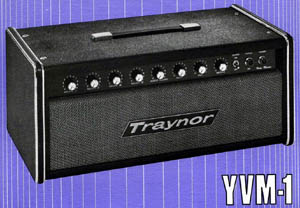
Features
Four inputs, each with its own volume control; master controls for volume, bass, treble, presence; on/off and stand-by switches and lamps
Early models use 7027s;
silvery grey grille cloth
Early Bass-Masters and Signatures are identical in appearance to the Voice Master.
four channel all tube PA amp
The amp is very much like a Bass Master with two additions:
1. There is an extra 12AX7 to allow four inputs rather than just two on the Bass Master. You don't really need four inputs - this gives you an extra tube plus two extra pots for all sorts of interesting mods.
2. The output transformer is tapped for 4, 8, and 16 ohm output - a useful bit of extra flexibility. It is switched and has 4 parallel output jacks - very convenient.
The control setup is different than a Bass Master. You have 4 input level controls, a master volume (but don't expect it to work like the ones on guitar amps,) and bass, presence, and treble controls.
But the stock circuit and circuit values on a YVM-1 Voice Master is almost exactly NOTHING LIKE a YBA-1 Bass-Master, as the two amps were designed for different purposes. The four parallel gain stages in the front end, with completely different circuit values around them (capacitive coupling to the inputs, 0 cathode resistance and 475K plate resistor) gives a gain response and tone that is unlike the Bass-Master.
The 7027A tubes could be replaced with 6L6 tubes without any modifications.
Four 12AX7s and two EL34s/6CA7s
The original tubes were 7027As - tough to find originals these days. The 6CA7s/EL34s work fine.
Three-position impedance selector on the back is labeled as follows:
- 4 ohm
---
- 2 ohm
There is a single jack (again out back) marked speaker, with three others tagged Extension.
On the back there is a "Power amp input" (which is not shown on the 1966 schematic). I assume this is where you would plug a preamp signal in. There is a "Mixer Output" (again not shown on the 1966 schematic). Is this actually a preamp out put? Is this like an effects loop sort o thing?
The "effect loop" level is matched for outboard reverb devices.
I tried effects through the loop on my YVM-1, and no sir, I did not like it. There was odd distortion and it sounded crappy to my ears. But effects through the clean front end sound good though...
Yes, the stock effects loop sounds like crap. If you can get your hands on a copy of The Ultimate Tone (www.londonpower.com), there is a schematic on page 7-11 for an excellent and very transparent, tube buffered effects loop. This loop is easy to build, and uses only one 9 pin tube position (usually a 12AT7). I have built it into several Voice Masters and it is a standard mod for me now.
If you really want a Plexi-style amp, you still have plenty of room on the main board, and enough tube positions in the stock amp to make it happen. Check out JC Maillet's notes on doing this at www.lynx.bc.ca/~jc/bassmasterMod.html.
My [1968] YVM-1 (serial number V-2581) has 16, 8, and 4 ohm switch. I tried the effects loop with a Fender satalite and it worked alright. However I'm using it with a bass.
The older models had 4-8-16 ohm switches while mine had 2-4 ohm switch only.
YVM-1 early version with Fender style wrap around cab. Sounded bland with guitar and tried bypassing the preamp through the power in jack but blew the tube in my outboard pedal preamp so cannot recommend use of that input. Instead changed channel one to Plexi and channel 2 to JTM. Sounds awesome now. Playing through a pair of Jensen from 1960s. Also have a pair of Celestions that are brighter and louder.
Note that the PPI is not a double side of a 12ax7 but rather a divider network it looks like, anyway. It sounds good and probably avoids issues with unbalanced/unmatched 12ax7s. also have a new pair of weber cap cans installed and next looking at a PPIMV. Another oddity is the diodes across the power tube outputs- these were on the Custom Specials as well and I see it is recommended to remove them.
I paid 300$ and have another 200$ into it including a tech at MainDrag Music..
Now selling my Boogie. (Tom the Canuck lost in NY)
Dimensions: 23" x 10" x 13"; weight: 42 lbs.
Sound
Straight up, this amp sounds like a Hiwatt. I use mine regularly for guitar.
The YVM-1 is very clean sounding, but can be modded to do whatever you want it to do (except wash your dishes!).
It does not sound like a Bass-Master, but rather like a sterile Fender, unless some mods are made.
I have tried it through my TS-215 cab with a Strat and sounds nice and clean.
The YVM-1 has a fairly flat frequency response compared to Traynor guitar amps and mine (used to own one) was sterile sounding with my Strat...
Reliability
-
Price
Bought a Voice Master YVM-1 for CAD $99, serial number V-2581 (indicating 1968), good score! A Voicemaster in decent condition for [CAD] $99 is a great deal. [October 2001]
This guy is asking CAD $200 or B/o. it is a point to point wired tube amp so I guess I can always get my $ back. [January 2002]
Rating
This is a pretty nifty amp - definitely more interesting than a standard Bass-Master. I think an early one with a choke would be more entertaining.
The Voice Master has become a popular guitar amp, even though it was designed as a P.A. head.
I feel that for overall features (reasonable weight/reasonable size/four 9 pin tube positions/and lots of holes on the back panel for mods) the Voice Master is my favourite Traynor amp to mod. They can be made to sound MUCH better than stock with a little
know-how and a little solder.
I personally prefer other Traynors for guitar, but the YVM-1 has mucho mod potential (4 inputs) and an extra 12AX7, as well as extra speaker out jacks and volume pots, etc!!! If the price is right, grab it.
A keeper.
I used to use the YVM-1 to drive a YBM-3. Just connected the speaker
outputs of the YVM directly into the YBA-3. Not sure why it worked so well.
But it sounded awesome. Used a Rogue Cabinet and a Norelco (YN412) with it.
Got the idea from a guy in a Toronto Band called It's All Meat in 1969.
Rate the YVM-1 Voice Master...
 YVM-1 Voice Master (old style, Fender-type wrap-around case; old logo), front view, angle (under a Custom Special) YVM-1 Voice Master (old style, Fender-type wrap-around case; old logo), front view, angle (under a Custom Special)
 YVM-1 Voice Master, catalog page YVM-1 Voice Master, catalog page
 YVM-1 Voice Master, schematic, early [version] with a choke and 7027A output tubes - I would expect later ones dropped the choke and used 6CA7 outputs - same progression as the YBA-1 Bass Master YVM-1 Voice Master, schematic, early [version] with a choke and 7027A output tubes - I would expect later ones dropped the choke and used 6CA7 outputs - same progression as the YBA-1 Bass Master
 YVM-1 Voice Master, schematic 11/1966 YVM-1 Voice Master, schematic 11/1966
(Billy,
Craig,
Dan Lear,
Denis,
Eric Knudsen,
Glen,
Karl,
Michael,
moo,
Moon Keith,
Phil,
Rob,
Roger Doger,
vivaAnalog at www.lynx.bc.ca/~jc,
www.schematicheaven.com)
|
|
|

|
YVM-2 Voice Mate
? watts,
solid-state head,
19??
|
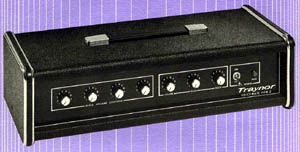
Features
Early models use 7027s?
Dimensions: 21 1/4" x 5 1/2" x 9 1/4"; weight: 14 lbs.
Sound
-
Reliability
-
Rating
-
Rate the YVM-2 Voice Mate...
 YVM-2 Voice Mate, catalog page YVM-2 Voice Mate, catalog page
(Eric Knudsen,
Moon Keith,
vivaAnalog at www.lynx.bc.ca/~jc)
|
|
|

|
YVM-3 Voicemate Reverb
? watts,
tube? head,
1972?
|

Features
Frontpanel: Four volume controls (upper left), four reverb selection switches (on left), intensity and tone controls (center), treble/bass/master volume controls (right);
Backpanel: Reverb footswitch input, four inputs, two cabinet jacks;
I use this amp around the house I have it on volume 1-2 when I'm jamming in a band i have it on 5-6.
It is very very heavy.
Also it has 8 7 inch speakers in 2 12 by 37 inch cases. [?]
Sound
I play grunge and its perfect for it. [...] When I play clean it sounds perfect. There is no distortion on it. I have to use a MT-2 or a zoom pedal.
Reliability
It has never broken down, but when my grand father gave me it the reverb was broken. To fix it all I had to do was solder the back the little wire that broke off of it.
Rating
I like the sound levels it can make and the reverb.
My friend has given me one of these [YVM-3 Voicemate Reverb] heads and I'm powering a 4x12 with it... it does a great job and supplies plenty of power [...]
Rate the YVM-3 Voicemate Reverb...
 YVM-3 Voicemate Reverb, front view YVM-3 Voicemate Reverb, front view
 YVM-3 Voicemate Reverb, back view YVM-3 Voicemate Reverb, back view
(Chad Collier,
Dan Lear,
James Duncan,
Jean-François and Monique et Gaétan,
Mike Lahaie,
vivaAnalog at www.lynx.bc.ca/~jc)
|
|
|

|
YGA-1 Signature
100 watts,
tube head and 1x15" tube combo,
1967
|
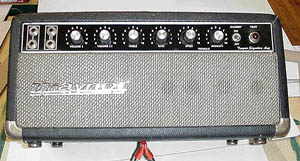
Features
Just opened up the [1967] YGA-1 that arrived today. No fiber board, but rather brownish hard plastic-like board, with small posts for connection points. Tube rectifier. All circuit connections dabbed with red paint/magic marker/something or other. 100% original. Handwritten initials inside the chassis look like B.T. Handwritten serial number 0103. Wow. That's kinda cool. The cabinet has corner protectors on all four bottom corners. Four rubber feet with shiny metal bottoms on base of the cabinet. Logo is the automobile-nameplate-looking thing, the long one, but not in script. Knobs not chickenheads, but the black barrel kind with metallic caps.
It works, kinda, sort of. It works enough to tell the tube rectifier is really noticeable to someone used to the '67 era diode-rectified YBA-1. The output is unstable, not sure specifically what causes that. This dead stock rarity needs a tune-up. The footswitchable tremolo is pretty nice to have. Could be interesting. Didn't seem like it's slowest rate was as slow as typical Blackface Fender trem. Didn't sound as intense either. With a
diode-rectified amp, that very trem could really add a nice shimmer to things. It's hard to appreciate it with an unstable tube-rectified 35-year old amp. Overall, the amp sounded a little bright. Tone controls seem more responsive on the '67 YBA-1. Presence and midrange controls might account for that impression. Again, the tube rectifier flavored the tones enough to distract my ears from really dialing a better tone. Plus, I run my Traynor heads through a Marshall 4x12. I face it towards the wall, then put it about six inches from the wall (which is padded and carpeted). It makes the experience less painful. Admittedly, these amps have no master volume. But serious tones come out of these amps at low settings, so does serious volume. The amp seems to reach maximum volume at about 2.5. After that you dial in more overdrive.
The amp which was photographed above and below was made in 1967, and has the serial number 0103. It has a tube rectifier. The photos show that it has 7027A output tubes. The YGA-1 looks like an early YBA-1, but it only has treble and bass controls (no high- and low-range expander). It also has footswitchable tremolo - another difference between it and the YBA-1. Other than the tremolo and EQ controls, it's essentially the same as a YBA-1 from the same era.
The Signature is basically a Bass-Master with tremolo.
Early models are identical in appearance to the Voice Master/early Bass-Master.
Comparing a 1967 YGA-1 Signature wth 7027 tubes with an YBA-1 Bass-Master with 6CA7s: Both use the same transformer set, and the major circuit difference is the inclusion of the vibrato circuit and controls. Sonically they are very similar. I like the Signature amp.
The differences are subtle, and largely represent the differences between 7027 (6L6) and EL34s, and rectifier types (tube vs. diode). My Signature has a tube rectifier, which has a little more sag than the YBA-1. It also has trem, which the YBA1 doesn't. I kept the 7027s in my Signature, but put Mullard EL34s in my YBA-1. [...] When [the YBA-1] ran on 7027s, it was a rock machine (think Black Crows, Zep, etc.). It probably has a bit less bottom end and more mids and highs now.
silvery grey grille cloth
Mine is a [solid state] rectifier model from around 1967.
A 1967 YGA-1 uses [originally?] 7027 tubes.
uses 7027 tubes, you can substitute 6L6/5881s
You can simply switch the 7027A tubes with 6L6GCs. No modifications are required. Bias and other most tube characteristics are the same - there will be no inherent tone changes (in practice your amp may sound different, but that is a result simply of the change in tubes, rather than the change in tube types). The 7027A has higher voltage ratings than all but the best 6L6GCs, but this is irrelevant for the Signature YGA-1, it runs with less than 450 VDC on the plates.
All tube sockets wired for 7027A tubes are compatible with any 6L6, but the reverse is not necessarily true.
If one were inclined to do such things, the extra preamp tube could be used to do a tube buffered effects loop.
I have swapped out the 4M volume pots for 1M, and put a 47K resistor
in the NFB loop. These mods are worth doing to any
Signature/Bass-Master, IMO.
The 1x15" combo version is 11 1/2 x 18 1/2 x 31" high. Cabinet weighs 80 pounds. (Tim)
Sound
I've tried the YGA-1 through a Marshall 4x12 and thought it was too loud to be useful. But through the 1x15 it sounded great. Killer vintage Page/Townsend tones.
these amps sound great after 30-some years, imagine what they sounded like when they were new. I'm guessing it's gonna be comparable to a Matchless Chieftain, minus that Class A hair the Chieftain adds to your tone.
Reliability
-
Price
CAD $253 [used], good condition, seen at Songbird Music, Ottawa, November 1998
CAD $260 [used], very good condition, seen at Songbird Music, Ottawa, January
1999
Rating
It's a cool little amp, and there are a lot less of them out there when compared to the Bass-Master. I like it.
I love the sound of this amp. The filtering is great, absolutely no 60hz hum. Converted easily to EL34 tubes.
Rate the YGA-1 Signature...
 1967 YGA-1 Signature (tube rectifier, 7027A output tubes), front view 1967 YGA-1 Signature (tube rectifier, 7027A output tubes), front view
 1967 YGA-1 Signature (tube rectifier, 7027A output tubes), back view 1967 YGA-1 Signature (tube rectifier, 7027A output tubes), back view
 YGA-1 Signature 1x15" combo, front YGA-1 Signature 1x15" combo, front
 YGA-1 Signature 1x15" combo, front close up YGA-1 Signature 1x15" combo, front close up
 YGA-1 Signature 1x15" combo, back YGA-1 Signature 1x15" combo, back
 YGA-1 Signature 1x15" combo, serial plate YGA-1 Signature 1x15" combo, serial plate
 YGA-1 and YGA-1A Signature, schematic 1967 YGA-1 and YGA-1A Signature, schematic 1967
 YGA-1 and YGA-1A Signature, schematic 1967 YGA-1 and YGA-1A Signature, schematic 1967
(Craig,
Dan Lear,
Eric Knudsen,
Michael E. Levy,
Phil Turton,
Songbird Music Ottawa at www.songbirdmusic.com,
Tim Casey,
vivaAnalog at www.lynx.bc.ca/~jc,
www.schematicheaven.com,
yorkville.com)
|
|
|

|
YGA-1A Signature
50 watts?,
tube head,
1967?
|
Features
Made in 1967. Two channels, two volume controls, four inputs, "expander" treble and bass, and tremolo speed and intenisty. The treble and bass can be turned way past 10 to the vertical down position to get really cool, Traynor called it expander knobs. You can link channel one and channel two to mix your normal and bright sound. It has a tremolo footswitch but no other accesories, like headphone jack, line out, etc. I changed the original 7027As for a set of 6l6GCs.
has 7027A output tubes; uses 7027 tubes, you can substitute 6L6/5881s
silvery grey grille cloth
If one were inclined to do such things, the extra preamp tube could
be used to do a tube buffered effects loop.
I have swapped out the 4M volume pots for 1M, and put a 47K resistor
in the NFB loop. These mods are worth doing to any Signature/Bass-Master, IMO.
Sound
I you a 61 reissue SG with Dimarzio PAF's. The amp is good for rock, blues, nothing that requires real high gain. Works nice with an overdrive pedal in front. It's pretty quiet considering it's almost 35 years old. Over all it sounds great to me. Nice and fat with a nice top end shimmer. It is very similiar to a JTM45 with 6L6s instead of EL34s. Not much overdrive, clean most of the way up. Pretty cool amp. Loud as hell. I love it. It sounds great and that's what counts.
Reliability
It's pretty old, I wouldn't want to carry it around to much. Seems sturdy but it's pretty old. It has never broken down as far as I know.
Price
-
Rating
-
Rate the YGA-1A Signature...
 YGA-1 and YGA-1A Signature, schematic 1967 YGA-1 and YGA-1A Signature, schematic 1967
 YGA-1 and YGA-1A Signature, schematic 1967 YGA-1 and YGA-1A Signature, schematic 1967
(Craig,
Dan Lear,
Eric Knudsen,
Michael E. Levy,
Shawn Chatman,
Songbird Music Ottawa at www.songbirdmusic.com,
Tim Casey,
vivaAnalog at www.lynx.bc.ca/~jc,
www.schematicheaven.com,
yorkville.com)
|
|
|

|
YGL-3 Mark III
100 watts,
2x12" tube combo,
late 1960's? 1972, 1976
|
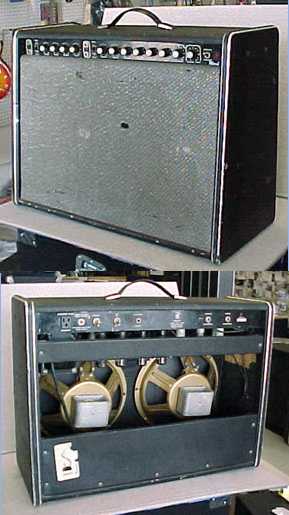
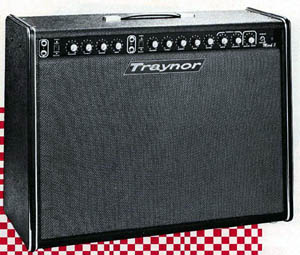
Features
two channels, each with volume, bass, middle, treble controls, treble boost switch; channel two has reverb and a really neat tremolo effect; master gain; effects are footswitchable;
for guitar;
one extension speaker output jack on the back panel;
Tubes are: Four 6CA7, one 6BQ5, five 12AX7A.
It says 4 ohms output impedance on the schematic.
It has a pair of 12" JBL K120s and a quartet of Mullard EL34s.
silvery grey grille cloth
REALLY heavy;
Dimensions: 27 3/4" x 21" x 12 1/2"; weight: 75 lbs.
Sound
lots of punch in the bottom and middle; distort naturally or use a pedal
can barely get it to overdrive, so it ain't no crunchy amp, but it has more than
decent tone; in fact, it's pretty good
THIS AMP IS CLEAN and LOUD!!!
It'll absolutely knock just about anything else right out of contention, both in volume and tooooone. [...] If you need/want the ability to stand up and be heard... for miles... go for it.
I use a Strat or Tele with stock pickups. I'm presently playing mostly blues now to which this amp is well suited because of its warm tones or capable of great highs with the boost switch. Its still a super clean sounding amp at low to mid-range but does buzz and crackle a bit a high volume. I think all Traynors did a bit even when new. Its a hard amp to overdrive without a pedal.
Amazing blues tone- particularly off of the front pickup of a Strat- and the tremolo is old-school, but it doesn't do all that breathing (which can get in the way if you are trying to do ambient stuff). The treble boost opens up a high-end that leaves you with that sweet Pete Townshend post-gig ear buzzing thing. As for the weight, who did they think they were kidding, only putting one little handle on the top? It's like trying to carry a bus with one hand!
I have a Traynor Mark III head with a Traynor YN-412 cab. I took out the whizzers (sounded kinda crappy) and replaced them with Eminence Legends (4 ohm). I was in a band with a guy who had a Marshall tube amp and a 1960 cab... My rig was and is way bassier and smoother. Paid $325 for the Mark III head and $140 for the cab. plus $120 for the replacement speakers. $585 for a rig that surpasses the Marshall by volume (check out the RMS of a Marshall and the RMS of a Traynor... hands down a Traynor slaughters!). [Sep 2002]
The Traynor circuit sounds [indeed] great. I also found that using .1uF caps instead of .01 slowed the tremelo down nicely.
For any keyboardists out there: The YGL-3 has plenty of power and my Wurlitzer electric piano really sparkles through it. I use a Visual Sounds RT-66 american overdrive pedal and it really worked well w/the YGL-3 at various configurations. Organ (Voce V5 midi module)
actually sounded better through my YBA-1 (I think its due to power-tube distortion, maybe 6L6GC vs. EL34 characteristics too) but its still new and I'll have to try some different tube and tone settings (I'm thinking a overdriven 12AT7 might work better for V1). Speaker compliment was: 12" x'd over at 800hz and a 8" behind a rotating baffle for mid/highs.
Reliability
excellent reliability
[I bought this amp new in 1972.] It has tons of power and over the years [1972-2000] all I've done is replaced the original speakers only once with new Celestions and re-tubed it twice. [...] It never let me down or broke down. Still have the original tubes for back-up.
Price
'a few hundred [US] bucks' [used]
US $275 [used], seen at www.guitarshoppe.com/guitaramps4sale.htm,
September 1998
CAD $375 [used], crudly cut down to a head, overpriced, seen at Used Music,
Ottawa, September 1998
US $700 [used], seen at a store in southern IL, US, outrageous price, November
1998
US $225 [used], 1976 or later amp, all original except for a missing logo on the front and two 6CA7 Ruby Tubes, satisfying purchase, November 1998
picked up a YGL-3 Mark III combo today for [US?] $250, it is in pretty good shape with just enough wear to give it character. Somebody had performed some interesting tube substitutions , a 12AX7 for the 6BQ5 and a 6L6GC for one of the EL34. I'm still surprised it wasn't smoking when I tried it out. Other than those tubes everthing else was original. [March 1999]
I paid $300 Canadian for it [in mint condition]. YEEE HAWWW. I have recently [in January 2002] seen a few for sale around the Toronto area for about CAD $350, [...] US $400 sounds a bit stiff.
Bought a mint 1976 YGL-3 Mark III, with all original components, tubes, speakers, switches, for CAD $250, from a private. [October 2000]
Rating
I love the sounds it makes.
Again, not a bad amp for a cheapie and my bass sounds amazing through it.
On a dollar to dollar basis Traynor built a fantastic amp that was as good as or better than any Fender or Marshall or anything else in its price range.
I have used a Mark III for road and studio use for most of my 30 years of playing.
My other amp is a fender twin from the mid 70"s i also used peavey and Randalls.
But i digress.
My Traynor though old and in need of some new tubes, is a real working mans amp!!
You can get a wide range of sounds from squeeky clean to gritty blues add your choice of distortion and you have it all. The speakers have never blown up! and I abuse them
the boost switch send it into ICEPICK IN THE EAR LAND pn clean or adds a nice bite when over driven all in all if you can find one BUY IT YOU won't be sorry!!!
I rescued my YGL-3 Mark III from an indefinate engagement at the local nuisance ground. These kindly old people who had bought it for their daughter who wanted to learn guitar back in the early 70's decided that it was just the wrong shape for draping afghans over. They were going to ditch it because someone had dropped it off of the back of a farm truck one time and now it didn't work. Turned out to be just the soldered connections which only cost a few bucks to repair. [...] This is the first guitar amp I've ever owned, but I've played through other gear and honestly, I'm not going shopping any time soon.
I bought my Traynor Mark 3 (my 2nd) 15 years ago [and it] still had the orignal Mullards in it [and] still [the] original speakers DAMN LOUD on clean [-] can get mild over drive.
If i have an outdoor gig I A/B it with a silver face twin for over drive clean
My friends joke and say I can only play canadian music Like Rush, Max Webster, Chilawhack,and BTO on it but when compared to myfriends Marshall super lead the traynor combo won hands down in clean loudness!
Rate the YGL-3 Mark III...
 YGL-3 Mark III, front and back view, angle YGL-3 Mark III, front and back view, angle
 YGL-3 Mark III (new style, removable top case), front view, angle YGL-3 Mark III (new style, removable top case), front view, angle
 YGL-3 Mark III, front view, angle (under a YGL-3A Mark III and a Vox) YGL-3 Mark III, front view, angle (under a YGL-3A Mark III and a Vox)
 YGL-3 Mark III, catalog page YGL-3 Mark III, catalog page
 YGL-3 review in Guitar Player, about 1971 YGL-3 review in Guitar Player, about 1971
 YGL-3 and YGL-3A Mark III, schematic 1976 YGL-3 and YGL-3A Mark III, schematic 1976
 YGL-3 Mark III, two english manuals, french manual, factory mod, YGL-3 and YGL-3A Mark III schematic, YGL-3 Mark III schematic YGL-3 Mark III, two english manuals, french manual, factory mod, YGL-3 and YGL-3A Mark III schematic, YGL-3 Mark III schematic
 YGL-3A Mark III manual, YGL-3 and YGL-3A Mark III schematic, YGL-3 and YGL-3A Mark III schematic 1972-1973, YGL-3 and YGL-3A Mark III schematic 1976 YGL-3A Mark III manual, YGL-3 and YGL-3A Mark III schematic, YGL-3 and YGL-3A Mark III schematic 1972-1973, YGL-3 and YGL-3A Mark III schematic 1976
(Ben,
Bernie & Michelle Girardin,
Dan Lear,
Darryl Dozlaw,
Dave,
Donnie,
Eric Knudsen,
Greg Gallant,
J,
Jean-Charles Maillet,
Michael E. Levy,
Michel,
Moon Keith,
Mr. Pants from "Mr. Pants' music gear!" at www.interlog.com/monkey,
Murphy Family,
rippersmusic,
Steve Willis,
vivaAnalog at www.lynx.bc.ca/~jc,
Wayne,
www.guitarshoppe.com/traynoramp212.htm/Traynor212GuitarAmp.jpg,
www.schematicheaven.com)
|
|
|

|
YGL-3A Mark III
100 watts,
tube head,
1976
|
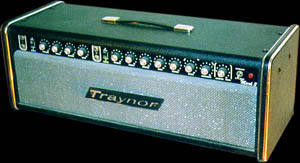
Features
two channels, each with volume, bass, middle, treble controls, treble boost switch; channel two has reverb and tremolo; master gain; effects are footswitchable?
two speaker output jacks on the back panel;
On the YGL-3A, the output impedance is 4 ohms (two 8 ohm speakers in parallel).
silvery grey grille cloth
Dimensions: 27 3/4" x 11" x 10"; weight: 47 lbs.
Sound
The sound is ok, a bit mean with reverb on 5, but useable for Blues and rock.
Reliability
-
Price
US $249.99 used, good condition, seen at Daddy's Junky Music at
http://www.ugbm.com/amp.htm, September 1998
CAD $395.65 [used], very good condition, seen at
http://www.songbirdmusic.com/ottawa/guitar/amplifie.htm, September 1998
CAD $75 used, cut down YBA-3, rough condition, 'a few years ago' in 1998
CAD $135 used, 'a few years ago' in 1998
CAD $396 [used], good condition, seen at Songbird Music, Ottawa, November 1998
CAD $375 [used], very good condition, seen at Songbird Music, Ottawa, January
1999
1971 YGL-3A Mark III. Best [US?] $75 dollars I ever spent. [before 2001]
1973 YGL-3 Mark III with 1973 YC-610 cab, it's in really in good order, all original, inside, outside and all the tubes. They say Philips on them, but I've never seen these Philips before. American? Together approx. [US?] $340 or DM600. I think that's a good price for something with this quality. [January 2002]
Rating
A very good amp I think.
I have owned the [YGL-3A] Mark III for 15 years, I haven't had any problems with this amp. I must say it's very loud and clean... works great with overdrive effects etc., you can get some great sounds.
I had a YN-412 with a Mark III head. It was a great sounding amp, unfortunately I sold it a few years ago but would like it back. I used it with a Telecaster and a Takamine EF-318 acoustic. Great sound with [the] acoustic as well.
Rate the YGL-3A Mark III...
 1973 YGL-3A Mark III, (removable top, with master volume), front view, angle 1973 YGL-3A Mark III, (removable top, with master volume), front view, angle
 1973 YGL-3A Mark III, (removable top, with master volume), front view 1973 YGL-3A Mark III, (removable top, with master volume), front view
 1973 YGL-3A Mark III, (removable top, with master volume), back view 1973 YGL-3A Mark III, (removable top, with master volume), back view
 1973 YGL-3A Mark III, front view (on top of a YC-610 cab) (same amp and cab as below) 1973 YGL-3A Mark III, front view (on top of a YC-610 cab) (same amp and cab as below)
 1973 YGL-3A Mark III, front view (on top of a YC-610 cab) (same amp and cab as above) 1973 YGL-3A Mark III, front view (on top of a YC-610 cab) (same amp and cab as above)
 YGL-3A Mark III, front view (on top of a Vox and a YGL-3 Mark III) YGL-3A Mark III, front view (on top of a Vox and a YGL-3 Mark III)
 YGL-3A Mark III, catalog page YGL-3A Mark III, catalog page
 YGL-3 and YGL-3A Mark III, schematic 1976 YGL-3 and YGL-3A Mark III, schematic 1976
 YGL-3 Mark III, two english manuals, french manual, factory mod, YGL-3 and YGL-3A Mark III schematic, YGL-3 Mark III schematic YGL-3 Mark III, two english manuals, french manual, factory mod, YGL-3 and YGL-3A Mark III schematic, YGL-3 Mark III schematic
 YGL-3A Mark III manual, YGL-3 and YGL-3A Mark III schematic, YGL-3 and YGL-3A Mark III schematic 1972-1973, YGL-3 and YGL-3A Mark III schematic 1976 YGL-3A Mark III manual, YGL-3 and YGL-3A Mark III schematic, YGL-3 and YGL-3A Mark III schematic 1972-1973, YGL-3 and YGL-3A Mark III schematic 1976
(Dan Lear,
Eric Knudsen,
EviLTwiN2SX,
Jean-Charles Maillet,
Moon Keith,
Murphy Family,
Phil,
Ronaldo,
Songbird Music Ottawa at www.songbirdmusic.com,
u87,
www.schematicheaven.com)
|
|
|

|
Mark IV (exists?)
? watts,
tube head/combo?,
19??
|
Features
-
Sound
-
Reliability
-
Rating
-
Rate the Mark IV...
(-)
|
|
|

|
Mark V
100 watts,
2x12" tube combo,
19??
|
Features
very heavy;
silvery grey grille cloth
Sound
It is basically Traynor's reply to the very popular twin reverb, so the sound
is very similair, this amp is loud, very powerfull;
blues to heavy heavy "alternative"
Reliability
so far the amp has been fine.
Price
They do seem to be fairly rare, even here in Toronto. You don't see them for sale that
often. [Feb 2002]
Rating
so far I love it.
Rate the Mark V...
(Craig,
Daddy Mac,
Dan Lear)
|
|
|

|
YGM-1 Guitar-Mate Reverb
? watts,
tube head/combo?,
1967
|
Features
silvery grey grille cloth
Sound
-
Reliability
-
Price
Guitar-Mate Reverb, YGM-1?, US $275 [used], seen at
http://www.hopkinspress.com/rays/amps.htm, September 1998
Guitar-Mate Reverb, YGM-1?, US $250 [used], seen at
http://www.skyport.com/sol/rjmusic/amps.htm, September 1998
Rating
I have two and I gig with them. A great small club amp. (Kim)
I really dig them I've got 2 left. I had 3. I'm pretty sure I had the actual YGM-1 pictured on Traynors site. I bought it from a guy in Saskatchewan off KIJIJI. I just traded that to a young fellow in St John NB.
Put a good speaker in them, tweek some values in the reverb circuit, cut out the bright cap (changed it to 250p) and cut out the presence cap too. The screen supply had a 12 ohm resistor... I upped that to 1K and then 470 ohm on each tube.
The trem is very good and so is the reverb. Very good little club amp. (Danny)
Rate the YGM-1 Guitar-Mate Reverb...
(Dan Lear,
Eric Knudsen,
vivaAnalog at www.lynx.bc.ca/~jc)
|
|
|

|
YGM-2 Guitar-Mate
25 watts,
1x12" tube combo,
1966
|
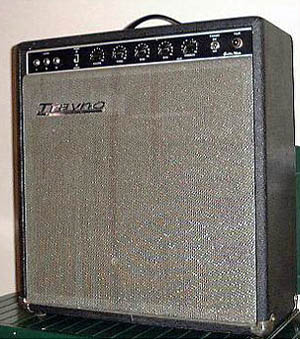
Features
It's a [25] watt combo, runs a pair of EL84 tubes, cathode biased, two channels (treble and boost), tremolo, bass and treble adjustment, but no reverb. The serial number [of my amp] is g-486.
silvery grey grille cloth
Sound
-
Reliability
-
Price
I just bought a 1970 YGM-2 Guitar-Mate from up North for [US?] $220 shipped.
Rating
Perhaps the only thing keeping it from being the perfect amp is the lack of reverb.
To tell you the truth, I really don't care for this amp. If you or anyone else is interested, I'd be glad to ship it to you for half that [US? $220].
Rate the YGM-2 Guitar-Mate...
 1966-ish YGM-2 Guitar-Mate (front, back, wiring) 1966-ish YGM-2 Guitar-Mate (front, back, wiring)
(Dan Lear,
Dave Gillespie,
Tim Casey,
Tom Becker,
vivaAnalog at www.lynx.bc.ca/~jc)
|
|
|

|
YGM-3 Guitar-Mate Reverb
20 watts,
1x12" tube combo,
1963? 1969? 1973?
|
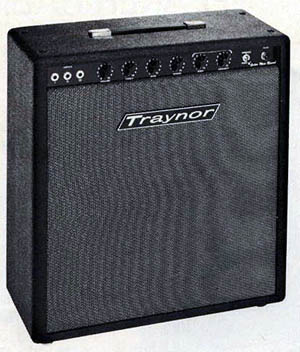
Features
volume, bass, treble, reverb and tremolo (speed and intensity) controls; treble boost switch;
reverb and tremolo are footswitchable via jacks in the back; there is also an 8 ohm extension speaker jack;
five 12AX7A pre amp tubes, two EL84 power tubes
silvery grey grille cloth
Dimensions: 22" x 23 3/8" x 9 1/2"; weight: 46 lbs.
Sound
the speaker is probably the weakest link in the chain;
"overdriven power tubes" sound; no kind of metal distortion with this one; just
a nice bluesy power tube crunch; I play surf with it.
This puppy barks big time!
I have a 1979 Traynor YGM-3 guitar mate combo. It sounds good, its kinda got that plexi sound like the old marshalls. Its all original, even got the original tubes and the speaker.
Reliability
built like a tank;
bullet proof
I bought mine new 30 years ago. It's had the piss beat out of it and all I've ever done is clean it up occasionally and replace the tubes.
Price
CAD $200 used
Songbird had a 'Traynor 50 watt head with reverb and tremolo, late 1960s? YGM-3, fair condition, for CAD $227' in June 1998
CAD $296 used, late 1960s, very good condition, seen at Songbird Music, June 1998 [described as 50 watt 1x12" combo with reverb and tremolo]
US $150 [used], modified, bought at a San Francisco shop, ca. September 1998
Guitar-Mate 1x12" combo, CAD $250 [used], seen at Gilles Grignon's site at Rainbow
Music at www.rainbowmusicshop.com/used.html, January 1999
I recently scooped up a 1976 Guitar Mate at a local thrift for [US?] $30, and have only found one problem with it. It hums when I use the reverb.
Rating
sweet little amp
I would buy this one in half a heartbeat, even if I already had one.
The YGM-3s have a bit too much midrange. I can hook up any guitar to the bass heads [YBA-2A and YBA-2B] and get a sweet sound without effects. But with the YGM-3s, YSRs, and Voice Masters, I need to modify the sound with peddals or an equalizer. In fact, the only guitar that sounds ok with the other Traynors is my Gibson L6s because it has midrange control unlike my LP and other axes.
A great little amp for blues and rock. Excellent crunch, sounds particularly good with a Rickenbacker guitar.
I just bought a 1970's YGM-3 via eBay and took it to band practice on the day that I got it. I was very pleasantly surprised by how well it performed. I've been using Fender Deluxes, but their expense has grown beyond their value. I guess the main difference between the YGM and the Deluxe would be the EL84s. I've found that I prefer the vibrato on my YGM (though the difference is slight and mostly due to the overall tone of the amp), and I also like the midrange boost of the EL84s. I don't know the wattage [20 watts] of the YGM-3, but the midrange boost does give the perception that it is slightly louder than the Deluxe. Other than the obvious cool factor of owning a Fender, I would rate the YGM-3 on par with the Deluxe. The Traynor, though, costs half as much!
1975 two input model with original Philips valves which show no sign of wear. [...] Great amp [...] the tremolo is superb, reverb also if used sparingly. The amp has benefited from replacement of the stock Marsland speaker for a Celestion Vintage 30. These amps are hidden gems amd worth seeking out even in the Uk.
Rate the YGM-3 Guitar-Mate Reverb...
 YGM-3 Guitar-Mate Reverb, catalog page YGM-3 Guitar-Mate Reverb, catalog page
 YGM-3 Guitar-Mate Reverb, catalog page YGM-3 Guitar-Mate Reverb, catalog page
 1975 YGM-3 Guitar-Mate Reverb, front 1975 YGM-3 Guitar-Mate Reverb, front
 1975 YGM-3 Guitar-Mate Reverb, top 1975 YGM-3 Guitar-Mate Reverb, top
 1975 YGM-3 Guitar-Mate Reverb, right side 1975 YGM-3 Guitar-Mate Reverb, right side
 1975 YGM-3 Guitar-Mate Reverb, left side 1975 YGM-3 Guitar-Mate Reverb, left side
 1975 YGM-3 Guitar-Mate Reverb, back 1975 YGM-3 Guitar-Mate Reverb, back
 1975 YGM-3 Guitar-Mate Reverb, back close 1975 YGM-3 Guitar-Mate Reverb, back close
 1975 YGM-3 Guitar-Mate Reverb, tubes 1975 YGM-3 Guitar-Mate Reverb, tubes
 1975 YGM-3 Guitar-Mate Reverb, inside 1975 YGM-3 Guitar-Mate Reverb, inside
 YGM-3 Guitar-Mate Reverb and YGM-4 Guitar-Mate Reverb (Studio-Mate), schematic 9/1973 YGM-3 Guitar-Mate Reverb and YGM-4 Guitar-Mate Reverb (Studio-Mate), schematic 9/1973
 YGM-3 Guitar-Mate Reverb and YGM-4 Guitar-Mate Reverb (Studio-Mate), schematic 9/1973 YGM-3 Guitar-Mate Reverb and YGM-4 Guitar-Mate Reverb (Studio-Mate), schematic 9/1973
 YGM-3 Guitar-Mate Reverb, schematic 11/1998; apparently there's an 'Error in this schematic. Reverb drive tube plates are tied together.
Compare to the scanned schematic to see errors.' YGM-3 Guitar-Mate Reverb, schematic 11/1998; apparently there's an 'Error in this schematic. Reverb drive tube plates are tied together.
Compare to the scanned schematic to see errors.'
(Alexis Fortier,
charcoal,
Dan Lear,
David Compton,
Denis,
Jackie Hull,
Jean-Charles Maillet,
John Templeton,
Karl,
Mike Baxter,
Mike,
Moon Keith,
Peter Beka,
Songbird Music at www.songbirdmusic.com,
Ttaborfamily,
vivaAnalog at www.lynx.bc.ca/~jc,
www.schematicheaven.com)
|
|
|

|
YGM-4 Guitar-Mate Reverb (Studio-Mate)
25 watts,
4x8" tube combo,
1972-9
|
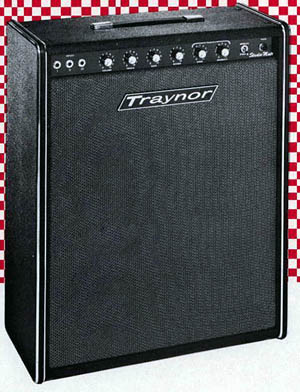
Features
The YGM-4 Studio-Mate is basically a YGM-3 Guitar-Mate with 4x8 speakers. Made from 1972 to 1979. It has two 6BQ5 (EL84) power tubes, with five 12AX7s. Other features include a 60's style Tremolo and a great reverb tank.
three inputs, tremolo speed and intensity, reverb, tremolo and reverb footswitchable
silvery grey grille cloth
Dimensions: 27" x 21 3/4" x 10 1/2"; weight: 57 lbs.
Sound
Great balsy sound.
Reliability
Like all of Traynor's amps, it is indestructible.
Price
For those interested in how fast people are catching on and buying these up and how prices are escalating rather quickly:
On January 15, 2009, I bought a 1977 studio mate for $450 (*tax incl.) in Ottawa, Ontario. There's another one selling at another store for $749 (*tax not incl.) Tube amps that are point to point, hand-wired would still cost more to build.
Even amp kits, you first build them, then build or provide for a cabinet & speaker(s), require more expertise than I have and can easily cost more than the YGM-4. [...]
As for my 1977 studio mate, I'm putting two TAD EL84 power output tubes in it, some vintage black plate JAN 12AX7s and a black plate JAN 12AY7 to lower the gain factor (because I'm a blues harp player), some special silver connectivity gel on all the tube prongs and tube damping rings.
Rating
A great sounding balsy tube amp available for a great price.
I've played harp for 25 years through two vintage 4X10 Fender Bassman amps, but got more compliments on my tone when I borrowed the 4X10 Traynor version belonging to our guitar player. To keep me from kidnapping that amp, he found the YGM-4 on eBay and snagged if for $250. I've only played a few gigs on it [...] I've realized that it is underpowered compared to the Bassman (running G6L6 power tubes). The Traynor clips much sooner, albeit pleasantly enough. Perhaps a new set of tubes would give back some headroom. Great combo amp for harp players going for a classic blues sound at low to moderate volume.
Rate the YGM-4 Guitar-Mate Reverb (Studio-Mate)...
 1974 YGM-4 Guitar-Mate Rever, front view, angle 1974 YGM-4 Guitar-Mate Rever, front view, angle
 YGM-4 Guitar-Mate Reverb, catalog page YGM-4 Guitar-Mate Reverb, catalog page
 YGM-3 Guitar-Mate Reverb and YGM-4 Guitar-Mate Reverb (Studio-Mate), schematic 9/1973 YGM-3 Guitar-Mate Reverb and YGM-4 Guitar-Mate Reverb (Studio-Mate), schematic 9/1973
 YGM-3 Guitar-Mate Reverb and YGM-4 Guitar-Mate Reverb (Studio-Mate), schematic 9/1973 YGM-3 Guitar-Mate Reverb and YGM-4 Guitar-Mate Reverb (Studio-Mate), schematic 9/1973
(BackStage (Joe Piazza's WorldWide Web Page) at www.servtech.com/public/piazza/joepage,
Dan Lear,
Eric Knudsen,
Jean-Charles Maillet,
Lame Buffalo,
Mike,
Moon Keith,
Richard Layton,
vivaAnalog at www.lynx.bc.ca/~jc,
www.schematicheaven.com,
www.servtech.com/~piazza/joepage/home/AmpImages/image005.h.jpg)
|
|
|

|
YSR-1 Custom Reverb
ca. 50-60 watts,
tube head,
1972
|
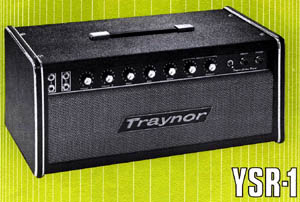
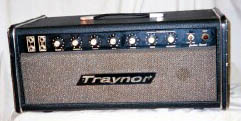
Features
Front panel left to right: Two channels, four inputs (two low, two high), two volume knobs (one for each channel), treble and bass controls, reverb control, tremolo speed and intensity controls, and standby switch (also has green and red lamps, green for operate mode, red for standby mode - VERY COOL!!!).
Rear panel left to right: Acc. plug, fuse, ground toggle, power switch, 2 speaker outs, and Trem & Reverb jacks (for footswitch(es)).
like a YBA-1 Bass-Master with reverb and tremolo
It does NOT have a master volume, middle or presence controls.
Huge Hammond transformers produce 45 watts from two 6CA7s/EL34s, six 12AX7s.
output speaker impedence is 8 ohms
Mine is an early model YSR-1, with a choke tranny. I believe it is from 1968. The rectifier is solid state. The [amp] cabinet is the "rounded" corner type, not the "pop-top" style.
My amp was made in January 1970, just after the choke was removed from the power supply filter stage (I have re-installed a 20H choke where the originals had one). The advantage is that it still retained a reverb driver transformer.
It seems incredibly more of a tonnally versatile amp than some would like to claim, though. Because it has 'active' tone circuitry (as opposed to front-panel Fenders, Marshalls, Hiwatts and most old amps with a Middle control), the frequencies are actually changed as you dial in more Highs or Lows. In other words, the Highs and Lows aren't a fixed frequency that gets cut as the dial is turned down. It's a healthy 50W, but the gange on the 4M (!) volume pots is very drastic; I'm pretty sure you can push 50W out of it with volume on 1 and a half on the bassy channel (channel I)...
The older ones don't have the chrome molding but do have both a red and green light indicating [the] status on the front.
Silvery grey grille cloth
Dimensions: 23" x 13" x 10"; weight: 44 lbs.
There must be some mod options available for the YSR-1, with six 12AX7s...
Mods on this amp are the power supply filter choke, a 3-prong AC cable, an appropriate output transformer and the ground switch converted to an impedance selector.
The tremelo is kinda nice but more of a novelty it not really about the features it about TONE!!!
Sound
Punk and alternative with Boss distortion pedal
This is the best clean sounding amp I've had. It has crystall clear highs and bassy lows and sounds excellent with the cab I use - a 240 Watt (i think) with 4x10 inch speakers.
Very clean, almost sterile at moderate volumes. Not as pleasing as the classic Fender
sound. At higher volumes, it breaks up nicely with a "Marshally" roar when played through
Celestion speakers. I play classic rock and don't need much distortion so it sounds fine for my needs.
What a killer amp!! It was pretty loud even with the volume at 2; the band that
owns it said it was actually too loud. So who says only Fender has the market
cornered on loud and clean sound?? The bright channel [is] really bright, almost
too bright.
I drive this amp with a quality older 12AX7-driver stomp-box and this thing just sings with sweet rich compressed distortion. I bought a Marshall 6100 head shortly after I got this
and only rate the Marshall better because I don't need a 12AX7-drive box to get the same sound. On the other hand, the YSR-1 has a sweeeet internal reverb and the Marshall
doesn't have any reverb... what a toss-up! The original schematic was still inside and the latest revision date on it says "Jul. 12, '71".
1971 YSR-1 Custom Reverb Tube Amp Head. It does sound GREAT and has not given me any problems.
I also own a '68 or '69 YSR-1 Custom Reverb, which does have a choke tranny, and other features, such as reverb and tremolo. But the tone is not as good as the Bass-Master, unless you wind it up. I find YSR-1 tone to be very tight, compressed, and slightly sterile (which is good with effects). Keep in mind, however, my YBA-1 runs on 6L6s and the YSR-1 runs on EL34s, which will account for a good part of the tonal difference. Both the YBA-1 and YSR-1 each have 4 input jacks, so I can jumper the channels and use both the bright and normal volumes to adjust my tone. This really works great!!!
The tonal difference between the YSR-1 and the YBA-1 is huge, IMO. But the YSR-1 has a good vibe of its own. I drive mine with a TS-9 Tubescreamer into a Marshall Guv'Nor (original issue) and through a Boss DD-3 delay. The sound is tight and in your face. Great for hard
rock/metal. OTOH, running these same effects into my YBA-1 gives a wetter and rounder tone good for blues, rock, and chicken pickin'.
My late sixties YSR-1 sounds pretty clean [...] it is a great amp.
Mine sounds OK but I'd like a little more drive, and maybe better reverb. I put a small bypass cap on one channel's preamp cathode. Definitely moving in the right direction.
I put a 1 meg volume pot in. That gives you more control over the volume at lower levels. I also revoiced the channels along Marshall lines: A 1.0 uf cap (couldn't find a .68) with 2700 ohm cathode resistor on one channel and a 250uf with 820 ohm resistor on the other. I replaced the .001 uf cap across the brite volume with a .0005 uf to tame the treble a
little. I don't think you can do too much about the reverb. It will never be a Fender.
With a 2x12 or 4x12, this would be a great gigging amp. Stick a pedal in front for overdrive, this baby stays pretty clean until it's really loud.
The amp is very loud and very clean. I was looking for a more Marshally tone so I modded mine - cascaded the channels so I have one channel stock (two 12Ax7 preamp stages) and one which has three 12AX7 stages configured similar to some of the later Marshall amps. I also added a master volume, channel switching, put a proper grounded plug on it and fused the output transformer primary. The new channel sounds great, very Marshally and has killer vintage tones thru Celestion Vintage 30s.
I have run this amp through a Marshall 1936 2x12 cab, and it sounds a bit sterile at
low-to-mid volumes (like Lee M. stated earlier), but I find that using a jumper cable to
blend the 2 channels adds more dimension and warmth. The amp begins to warm up around with the volume at 2-3. [...] The tone controls are not too effective, but they get the job done (like a Marshall). A mid control might be a nice addition, but I can live without it, and I want to keep this amp as original as possible. The reverb is adequate, and the trem is very nice. I noticed the power tubes pulsing along with the trem! [...] I have not cranked it much yet, but it is pedal friendly. I have run a Boss OD-1 and tube distortion pedals into it with excellent results. Chorus, flanging, phasing, and digital delay sound very warm and clear.
There is no master volume. This amp will distort at higher volume levels, but that is TOOO loud for my basement - so I use a dist/od pedal to do this. I like the transparency this amp has with pedals, so I find it very flexible. The amp is quiet, and sounds very "woody" with my '74 Stratocaster, thus representing my guitar properly. It does the Chris Isaak "Wicked Game" thing very well. I would not recommend this amp for heavy metal, unless an outboard distortion device were used. But I really appreciate how it reproduces my guitar tones. I would rate it higher if it were not as sterile sounding at lower volumes.
Rocks out for just about ANY style of music. [...] I wish it had a mid pot/knob (not that it really needs it, but...). I use this amp in my home studio and at large venues and club gigs. It is more powerful than I will ever need it to be. It Wails! [...] Its sounds kick ass all around. It's very clean. You get a great blues distortion sound without using any effects. For effects I have all 22 Danelectro Pedals daisy chained and secretly rigged so I still have a strong amp signal. These work like a dream with this amp.
This is an abolutly great amp. Good for Stray Cats style rockabily to outright rock and roll. I use it with a '92 Strat and '81 Gibson Sonex 180 (buddies, basically a bolt on les paul with hot pickups). No master volume so put a good overdrive in front of it and it sings. For rhythm I have a simple Boss OD-2 and lead a Vox Dist-Booster. Works great, from CCR to Bad Co. to Sabbith. Tweeking the nobs is a little different with the dependant tone control. Reverb sounds good but gets "spooky" when turned up. Tremolo is nice, not a lot of personality but it works good with little noise. I even use the darn thing for bass with no problems.
At first, I found the reverb rather weak (us Surfmongers NEED our 'verb...) in comparision to the dry signal and was dissapointed with the amp's name; I'm used to playing my amps with their tone controls maxed all the time. Later, I realized that the tone controls are in parallel to the reverb rather than the typical 3M resistor! This means that with the bass+treble turned to 0 and 'verb to 10, ALL you hear is the tank, *zero* dry signal. So now, with my bass on 2 and treble on 3 (reverb on 10, of course), I get a nice wet sound. The tremolo on this amp is power-amp-bias style, so it's very fine indeed; it doesn't go quite as slow as I wish it did though. [...] The amp is deathly quiet with the filter choke; without it, the reverb had a terrible 60Hz hum all the time (which is why, I presume, they trashed the reverb driver transformer). [...] This amp is worthwile for any one that digs REAL Rock 'n' Roll; circa '56-'68 (RIP). Get a nice cab too, they make a big difference.
The sound of this is amp is very clean and very loud (I haven't played it above 2 and usually run it at 1). With the Marshall JTM-C212 cabinet (2x12 wired for 4 ohms) it has a lot of bottom end and a lot of upper mids. I also have a Mesa Boogie DC-3 and it (not suprisingly) has a darker clean tone than the YSR-1 through the same cabinet. With this amp I only use the normal inputs. The bright inputs have too much treble for me. The tremolo is kind of a cool novelty. Reverb is OK to my ears but I don't think I'm that picky. The amp is pretty quiet at all volume settings. Not too much variety with this amp - it's really just a simple clean amp with basic tone control. Still, for what it does, it does it pretty well.
I bought my YC-610 with a Custom Reverb head after a fellow failed to
sell it on ebay around August of 2000. He told me that people asked him
about the tone of the rig. When he responded with loud and clean, they
all lost interest. I got in my car the next day with $350 in hand and
headed to Pennsylvania to buy it. As soon as I saw the pair I was in
love. They were both spotless. I got them home and powered up. It
sounded constipated and lifeless. Our drummer was less than enthused as
I disconnected the head and hooked it up to my Marshall 4x12. It
exploded with huge, hairy AC/DC-type tone. This YC-610 was clearly no
guitar cabinet.
I still use the Custom Reverb as one of my main heads (I bi-amp via a
Lehle switcher) and have yet to retube or bias. I predict a cap job in
it's near future.
Reliability
This amp is very reliable.
It's built like a tank with the biggest output transformer I've ever seen.
It is reliable.
Pretty rugged; only drawback [is that] the reverb [is] rather sensitive.
This is a great sounding reliable amp!
Legendary Traynor construction.
I haven't had any problems. [...] I have 100% trust in this amp.
This amp should easily last another 30+ years. Traynors (esp. the tube models) generally are very reliable.
Well, its 3/4 open if not full volume when I play and have had no problems to date.
When I got the amp the output tranny was FRIED (even smelled like BBQ sauce!). I replaced it with the appropriate Hammond transformer (same company that made the originals), with intentions of rewinding the original eventually. This amp scares me a tad because transformers don't burn up for no reason... The tubes (2x Westinghouse EL34s) that came with it -and that were in the amp when it burned up- still measured good, so I figure the amp was just pushing too much power. Because of this, I'm somewhat reluctant to crank it. Anyway, the Hammond tranny is rated at 60W (can probably take 80W or so because of Hammond's crazy underating tendencies), so eventually I'll get enough adrenalin in me and crank the darn thing.
Its quite old but solidly built. High quality Hammond transformers, rest of the parts are
decent. Point to point and circuit card wiring which is easy to modify. Traynors have a
reputation for being bulletproof and this amp seems to bear that out.
I haven't had the amp long but it is almost 30 years old and still looks as though it's all
original - that means something I guess (it has beer stains so it must be used somewhat!).
The part quality looks pretty high - it has a Hammond A1310 power transformer and a huge
Hammond A1312 output transformer. It's about twice the size of the one on my [Mesa] DC-3. It's point to point wired using cloth covered wire (really important ;-). The wiring looks a bit messy but not disastrous. All the tubes have metal shielding cans. This thing would be much easier to fix than my DC-3 which has a PCB and about a zillion tightly wired flying leads. One downside is that it's fixed biased but installing a bias pot would be easy.
Price
US $75 used
US $100 used
I currently own and operate a YSR-1 head and YT-15 cabinet. I bought/haggled the pair at a pawn shop for [US] $125 back in September 1997 in Michigan. They look rather used but not
trashed. The head, when purchased had one 6CA7 and one 6L6GC for output tubes which were older and deader than dirt; yet the amp still powered and didn't blow up... just noisier and flaky as hell! I had to repair all front panel pots as the internal wipers had all fallen off in the pots (the miracle of patience & jeweler's screws fixed this :) ). A new set of Sovteks all through brought this sweety back to life.
US $199.99 used, fair condition, seen at Daddy's Junky Music at
http://www.ugbm.com/amp.htm, September 1998
Found near a dumpster, reverb and tremolo not working, two tubes missing, San
Diego/CA, 1998
US $189 [used], seen at an Ebay auction, priced above market, October 1998
CAD $376 [used], good condition, seen at Songbird Music, Ottawa, November 1998;
CAD $360 in January 1999 for this same amp
US $75 [used], "This piece is toast, but unlike the corpse Lab L-11, this thing would be cool if you fixed it. Channel II doesn't work at all, and channel I is wide open, always on ten, el blasto. Reverb doesn't work - missing three knob caps."; seen at Daddy's Junky Music Auction (http://www.rockauction.com/os/category/AUCcur101.shtml?101), December 1998
1972 YSR-1 Custom Reverb, bought for $125 Canadian at Songbird Music in Ottawa about six months ago [so that must have been in about December 1998]. It was in very good condition but the reverb channel hummed. I bought it and determined very quickly that the wires to the reverb tank had been reversed, that fixed the problem. Everything else worked perfectly. I discovered later that it had two vintage brown base Mullard El34s in it, which are supposed to be among the best sounding EL34s ever made. What a bargain!
US $150 [used], "a beauty" without a name plate, "recently" in January 1999
Songbird always has a couple in stock but they usually ask [CAD] $300-400. I just saw a Bass-Master in the paper today for [CAD] $200 with a cab, I may take a look at it. [May 1999]
I found a YSR-1 with cabinet for [US?] $350 overpriced [September 1999]
YSR-1 CAD $360, used [November 1999]
1970 YSR-1 CAD $25 [December 1999]
1971 YSR-1 Custom Reverb with two EL34, CAD $225 at Cash Converters pawn shop [April 2000]
A YSR-1 sold on Ebay for US $290. [April 2000]
I have an opportunity to buy a YSR-1 Custom Reverb with a YT-12 cabinet. Everything is supposed to be in pretty good condition and working well. Is $375 Canadian a decent price for the package? [May 2000]
I have seen these heads go for close to US $300 so I think that sounds like a good price. [May 2000]
Sold the Custom Reverb locally. I took [CAD?] $320 for it and a 2x12 cab that I had built with a pair of Celestions. Probably could have done better on Ebay but shipping is a real pain so I took the cash. [October 2000]
I'm putting my YSR-1 on Ebay tonight. The last one of these went for [US?] $290. I'll take $225 plus shipping from 46635 if anyone is interested. This amp is virtually stock except for the following upgrades: 3 prong cord, new filter caps (LCRs), new bias caps, adjustable
bias. I have also revoiced the two inputs as a bright channel and a bass channel, similar to a Marshall Plexi and installed a two-wire master volume (in existing hole) on back panel. The dual mono footswitch jacks have been replaced with a single stereo jack. All the mods are easily reversible. Good cosmetic condition; a few burns on the tolex (not
through), some snags in the grillcloth, chrome is peeling on the trim. [October 2000]
1971 YSR-1, used, US $200 ['a long time' before December 2000]
197x YSR-1, used, US $300 [before January 2001]
1972 YSR-1 and 1972 YF-10, used, US $250 [January 2001]
1968 YSR-1, used, CAD $175 [February 2001]
I pulled a YSR-1 from a scrap heap. [November 2001]
Rating
Overall this is one hell of an amp, like I said before it blows any 100 watt Marshall away.
Sounds good for clean sounds
This is the best clean sounding amp I've had
One of the best values available in a vintage tube amp.
I have a YSR-1 with a YC-610 and an old Traynor Reverb unit. This stuff is priceless to me!!!
I love this amp! I'm keeping my eyes peeled for more Traynors.
My YSR-1 is not as beastly and touch responsive as my '66/'67 Traynor YBA-1 Bass-Master, but is special in its own way. It does share the same model output tranny and choke tranny as my YBA-1, however. Plus, I like the addition of reverb & trem. [...] I rate my YRM-1 second to my YBA-1, because it does not have as much balls. Also, my YBA-1 sounds great at all volumes, including low setttings. The YRM-1 is good sounding, but not as responsive, raw, or soulful as my YBA-1. Still it has a very good feature to value ratio and looks killer!!!
I can't see myself EVER replacing this amp.
Well, for $25, this is the best amp money has ever bought me! I reallly dig it and wouldn't
change a thing about its design. I'm a big fan of tube amp distortion, but not the point of
desiring a 5150...
If I saw another one of these amps anywhere near this price [CAD $125] I would buy it in a heartbeat. For classic rock tones on the cheap it can't be beat.
It's not that flexible but it's a good clean amp - not as good as an old Fender though. I bought for its clean sound and because Fenders and Marshalls are going for ridiculous prices around here.
I have been using the YT-12 cabinet with my YSR-1 Custom Reverb amp for about 15 years and I will never give up my head unit or cabinet for anything. Neither one has given me any problems, and the sound quality is unmatched.
Rate the YSR-1 Custom Reverb...
 YSR-1 Custom Reverb, front view YSR-1 Custom Reverb, front view
 1971 YSR-1 Custom Reverb, front view 1971 YSR-1 Custom Reverb, front view
 1971 YSR-1 Custom Reverb, partial back view 1971 YSR-1 Custom Reverb, partial back view
 YSR-1 Custom Reverb, catalog page YSR-1 Custom Reverb, catalog page
 YSR-1 Custom Reverb, catalog page YSR-1 Custom Reverb, catalog page
 YSR-1 Custom Reverb, schematic YSR-1 Custom Reverb, schematic
 YSR-1 Custom Reverb, schematic 1/1967-1972 YSR-1 Custom Reverb, schematic 1/1967-1972
(Alex Fortier,
Axeist,
Ben,
Cavemaaan,
Cj,
Dan Lear,
Dave,
David Fowler,
David Vernon Falkenau,
Donny,
Eric Knudsen,
Glen,
guildman,
Jim Jones,
Larry,
Lee MacMillan,
Moon Keith,
Patrick Walsh,
Phil,
Rich Heslip,
Rob,
Songbird Music Ottawa at www.songbirdmusic.com,
t_zero,
Tony S.,
William M. Pearson II,
www.schematicheaven.com)
|
|
|

|
YSR-2 Signature Reverb
ca. 50-60 watts?,
4x10" solid-state combo,
1972?
|
Features
[It] weights a ton
I picked one up-but it has no tubes [i. e. is solid state].
Sound
i play metal but without any effects this amp has a very clean sound.
The following is taken from the head version of this amp:
Punk and alternative with Boss distortion pedal
Very clean; for basic rock and roll
What a killer amp!! It was pretty loud even with the volume at 2; the band that
owns it said it was actually too loud. So who says only Fender has the market
cornered on loud and clean sound?? The bright channel [is] really bright, almost
too bright.
Reliability
The following is taken from the head version of this amp:
This amp is very reliable.
Built like a tank.
It is reliable.
Pretty rugged; only drawback [is that] the reverb [is] rather sensitive.
Price
I traded it with friend of mine for a fender bass amp.
Rating
I've had this amp for about 3 years and the damn thing sounds better than most new amps i've heard. [...] i had never even heard of TRAYNOR before but it was big, loud, and it sounded great. i knew it was old but i would never have guessed it was older than me. both channels on it work and my ears hurt with the volume at half way. THIS THING ROCKS. [...] the only bad thing about it is its so damn heavy. [...] all i know is that it is a good, reliable amp and if anyone is lucky enough to get their hands on this model they'll love it!
Rate the YSR-2 Signature Reverb...
(Bob,
Michael Bishop,
Shane Adams)
|
|
|

|
YBX-1A
100 watts,
tube head/combo?,
1973
|
Features
fan cooled;
silvery grey grille cloth
Sound
-
Reliability
-
Rating
-
Rate the YBX-1A...
(Dan Lear,
Garnet MacPhee)
|
|
|

|
YRM-1 Reverb Master
50 watts,
tube head,
before 1979
|
Features
one channel, two inputs, boost/normal switch, bright switch which affects both,
gain, bass-mid-treble three band EQ, reverb knob, tube vibrato: speed and
intensity knob, master volume, operate/standby switch, a light;
three-wire grounded mains cable, power receptacle on the back panel;
ground switch, power-on switch;
two speaker outs, tremolo and reverb footswitch jacks.
based on EL-34 power tubes and 12AX7 preamp tubes,
circuit breaker protected
Sound
clean and wonderfull; extremly dark, smooth, low gain EL-34 distortion
Reliability
this amp is extremely dependable
Price
US $200 used, 1979
US $200 [used], a 1973 YT-15 cab with a 1973 YRM-1 Reverb Master head
Rating
this amp and I got along great, but I always wished for more brightness and more flexibility
I currently own four (4) of these marvelous boxes of ear candy !!! I just cant seem to get enough of the best amp ever made. Well, I might be a little biased (pun intended). Well, the only mod I have done is to use a fender jewel type pilot lamp, tapping in to the filament supply. I just couldn't resist the look! I have different style EL34's in each just cause. And I think the one with that ended up with a pair of large bottle tubes marked 6CA7. I took one of the schematic sheets from the inside of one my amps and had it laminated to preserve it. The whole TRAYNOR YRM-1 thing is just too cool for words (even the jellyfish will agree to that).
ABSOLUTELY BULLETPROOF!!!
Rate the YRM-1 Reverb Master...
See Bob Womack's review of the YRM-1 at www.in2guitar.com/traynor.html!
(Bob Womack,
Dirk Spencer,
Malcolmdorian,
SEB,
W. Petrishen)
|
|
|

|
YRM-1SC Reverb Master
? watts,
4x10" tube combo,
197?
|
Features
high and normal input, boost/treble switch, volume, bass, midle, treble, reverb,
tremelo intensity and speed, and master volume;
two EL34s (I think);
very heavy wood construction;
blackface
Sound
this amp sounds soooo sweet, like an old Fender Super Reverb; it has a very
nice tone and sounds great when using both my Telecaster and my Les Paul, the
reverb is quite lush, and the tremelo sounds cool too at times
boy does it sound sweet!
Reliability
-
Rating
this amp sounds awesome!
Rate the YRM-1SC Reverb Master...
(Allen)
|
|
|

|
TS-10
10 watts,
solid-state combo,
197?
|
Features
Yorkville built the Traynor TS-10 to meet two needs. First, it was an entry level [guitar] amplifier for new players. Second, it could serve as a very small, highly portable, practice amp for more experienced players. I fell more or less in the second category when I bought mine in 1984. I [...] wanted an amp that took up no space, and that would be easy to [lug around]. [...] Eighteen years [...] later, it is still my main practice amp.
It is a solid state, combo design. There are four controls on the top of the head, the on/off switch, tone, volume, and master. You can create various distortion and overdrive effects by playing with the relative levels of the volume and master settings. For a clean tone, you set the two levels equally.
There is one input jack and one headphone jack. Every practice amp should have a headphone jack. In the little cabinet section there is a seven inch, ten watt speaker.
Sound
It [...] has a remarkably 'big' sound for its ten watts. I have carried it into jam sessions (under my arm) and held my own with guys playing big Fenders and Marshalls. I have no hesitation about miking it and using it onstage in a pinch. The tone is also surprisingly warm and full for a solid state amp.
Reliability
Extremely durable and reliable, it has never been in the shop.
The cabinet has protective metal flanges on each of its eight corners and a vinyl carrying strap on the top. The cabinet is small and very easy to carry in one hand, but built to last.
Price
US $69 [used], seen at www.billsmusic.com/amps.html, September 1998
Rating
It would be futile to try to rate this amp against other amps that were built for other purposes. But, based on the needs it was intended to fulfill, after all these years of satisfaction, I rate it a perfect ten. If you're in the market for a highly compact, but playable amp, by all means pick up one of these if you can find one. But, you can't have mine!
Rate the TS-10...
 TS-10, front view, angle TS-10, front view, angle
 TS-10, top view TS-10, top view
(David Rintoul,
Eric Knudsen,
John)
|
|
|

|
TS-15
15 watts,
2x8" solid-state combo,
197?
|
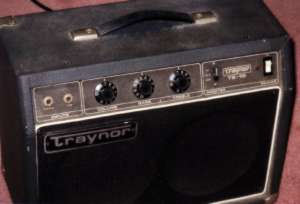
Features
The TS-15 is a small guitar practise amp. It has volume, bass and treble controls. It also has a three-way slider type switch that seems to cut the wattage. It is a low, middle and high. I gotta tell ya', it's a loud 15 watts on the high setting. With the volume past 4 (or so) it really kicks some ass. [...] It has two 8" speakers... they're called sound transducers.
[...] the three way slider switch is not so much for cutting wattage, but rather like a preamp volume control, like the master/slave volume control on many amps, but as a slider switch instead of a potentiometer. It lets you overdrive the amp to get distortion, but at lower overall volume. A great feature.
Sound
It has a real cool tone to it. Yes, it's transistor! [...] The amp is somewhat touch sensitive when cranked. It can really get saturated with distortion on ten.
Reliability
-
Price
I recently [April 2003] purchased a TS-15 at a pawn shop for [US] $60.
Rating
I wouldn't mind owning a couple more of them. I play old chicago style blues and I'm really digging the tone I'm getting out of this little gem...
Rate the TS-15...
 TS-15, front view, angle TS-15, front view, angle
 TS-15, front view TS-15, front view
 TS-15, back view TS-15, back view
(Eric Knudsen,
Satnam Singh,
Steve Bailey)
|
|
|

|
TS-25B
25 watts,
1x15" solid-state combo,
1979
|
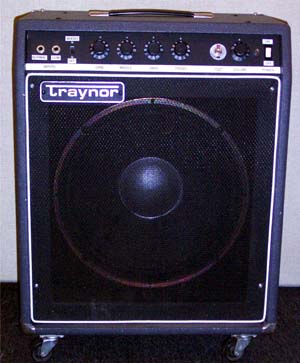
Features
Bass amp with a single channel, two inputs, boost/distortion switch, gain, middle, bass, treble, master volume controls, on/off, line out, 8 ohms 50 watts 15" speaker
Dimensions: 25"x21"x13" (HWD); weight: 47 lbs. or 21 kg
Sound
Sounds great [with guitar].
Reliability
Very reliable.
Price
Paid [US?] $225 for a Hondo Les Paul copy and the amp. [April 2002]
I just refurbished one which I bought at a hock shop for $49.00 cnd; I had to clean it up and replace the 15" woofer at $25.00 cnd; total $75 dollars cnd. Not bad for my Studio amp. [Nov 2003]
Rating
This amp has endured years of abuse [since 1981], and still has a very nice sound. I use it as my practice amp now, and can attest to the excellent construction, durability, and reliability of this little amp. I cannot remember what I paid for the amp, but I do remember it was not a great deal, and it has seen me through gigs during which I found it necessary to crank it up far beyond what I thought it would endure, and it has come through it all in superb shape. I have used it on many jazz gigs, and it has never given me a single problem.
I agree, nice amp.
Bought mine new in the 70's in England and apart from a couple of blown fuses still looks and sounds like the day I bought it.
Small power output but only use it at home. What it does give is a true low bass sound missing from the tiny modern 25 watt amps. Don't think I'll part with it now.
Rate the TS-25B...
 TS-25B, front view TS-25B, front view
 TS-25B, back view TS-25B, back view
 TS-25B, manual, two schematics 3/1979 TS-25B, manual, two schematics 3/1979
(Brian,
CJ Barr,
Elias,
John The Guitarist,
Mike Lahaie,
Richard Greiner)
|
|
|

|
TS-50B
50 watts?,
solid-state head,
197?
|
Features
Bass amp;
The styling is much like a Fender Bassman with only a single channel.
Basically a cuboid around twice as wide as high or deep, with a control
panel on the front top surface angled back at 45 degrees. The control
knobs are oversized (not a bad thing on a darkened stage as this amp [is]
basically all black) with (in order) gain, mid, bass, treble, volume,
on/off controls.
Sound
-
Reliability
-
Price
65 [English] pounds [used], seen in Manchester in a shop on Oxford Road, near
the university, October 1998
Rating
-
Rate the TS-50B...
(Aaron Turner)
|
|
|

|
TS-100
120 watts,
2x12" solid-state combo,
1980
|
Features
Open back combo with 2x12" speakers; black; black cloth with white border grill;
silver and black Traynor name plate;
Front panel (from left to right): Input = in and out... 1/4" jacks; gain; bass;
treble; inputs = off and boost switch with small red indicator light, normal,
and low 1/4" jacks; gain; middle; bass; treble; reverb; bright and red lighted
on/off switch; white power on/off switch;
Back panel (from left to right): Circuit breaker = push button... press to
reset; speakers 1/4" jack, 4 ohms min., 120 watts @ 4 ohms; foot switch boost
1/4" jack; line out 1/4" jack
Sound
Great sound under 70% classic disstortion no tubes 'i think'
Reliability
Since there is no tubes there are no tubes to replace. Never had to service - owned for four years and school owned till bought.
Price
I got two TS-100s from school for free one was mint and worked one didn't .
Rating
-
Rate the TS-100...
(Stephen Snider,
Thierry Boehm)
|
|
|

|
TS-100B
100 watts,
1x12" solid-state combo,
197?
|
Features
Bass amp
Sound
-
Reliability
-
Price
-
Rating
I plugged into it for a song at practice and I was relatively impressed. It
didn't sound much worse than my AMP BH-420 into my Carvin 2x10 Redline wedge,
which is a pretty good sounding rig (for solid state)
I use to play guitar through ts 100b and due to the graphic it was fine, I now wish I could get another but I cannot even find a photo, I did however change the speaker to a 100 watt celestion.
Rate the TS-100B...
(Ian Forshaw,
KO)
|
|
|

|
TS-120B
120 watts,
solid-state head,
197?
|
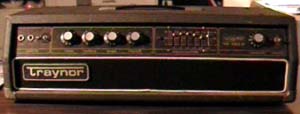
Features
Bass amp
Features Front Panel:
-Normal and High output jacks for guitar or bass
-Boost toggle switch
-Master gain control
-Master Volume control
-Mid control
-Treble control
-Bass control
-6 band EQ (50, 100, 200, 400, 800, 1600)
Back Panel Features:
-Circuit breaker
-2 speaker output jacks on back panel (4 ohms @ 140watts each)
-Foot switch outputs on back for EQ and Boost
-Balanced line out
Sound
-
Reliability
-
Price
I have one of these heads I acquired for $150.00 back in the mid 80's.
The only thing I have had done to it is a new toggle switch for the 'boost' feature. They cleaned it up and made sure everything was functioning.
Rating
Its old but good.
Great head!
It is currently going thru 2x15" Electro Voice speakers, one for low end the other for higher frequencies. No complaints at all, I love it! :)
Rate the TS-120B...
 TS-120B front TS-120B front
 TS-120B back TS-120B back
 TS-120B inputs jack and boost switch TS-120B inputs jack and boost switch
 TS-120B gain, middle, bass, and treble knobs TS-120B gain, middle, bass, and treble knobs
 TS-120B EQ TS-120B EQ
 TS-120B volume knob TS-120B volume knob
 TS-120B circuit breaker knob and speaker jacks TS-120B circuit breaker knob and speaker jacks
 TS-120B foot switch and balanced line out jacks TS-120B foot switch and balanced line out jacks
(Joe,
stuart_cox)
|
|
|

|
TS-200
200 watts,
solid-state head/combo?,
19??
|
Features
one channel, mono, three out jacks (2 for running into your cabs and a line out
jack), no reverb, four frequency knobs wich is rare on guitar amps (400, 800,
1600, and 3200 htz) so you can shape your sound
Sound
this is a VERY LOUD LOUD LOUD amp; WITHOUT DISTORTING AT INSANE VOLUME LEVELS;
twangest of country sounds to the cleanest of clean sounds to the most
thundering of thunderest metal (use a boss pedal) (guitar?)
Reliability
no trouble at all
Price
CAD $400 used
US $189 [used], seen at www.billsmusic.com/amps.html, September 1998
Rating
this simple head is everything I will ever want in a head and more than I will
ever need in sound and volume
Rate the TS-200...
(David Benson,
Eric Knudsen)
|
|
|

|
YF-10 cabinet
200 watts,
4x10" cabinet,
mid 1960's
|
Features
According to the Yorkville/Traynor website, it is a 200 watt 8-ohm cabinet w/ Marsland speakers.
silvery grey grille cloth
Sound
less bass, but more punch; for bass and guitar
The YF-10 speaker cabinet sounds smooth and rich and is less subby sounding than the twin 15 cabinet. I also found these cabinets produce a sound with more definition than the twin 15". The sound could heard better and it seems to project further than the twin 15".
Reliability
-
Price
US $179.99 used, good condition, seen at Daddy's Junky Music at
http://www.ugbm.com/amp.htm, September 1998
US $169.99 used, good condition, older, seen at Daddy's Junky Music at
http://www.ugbm.com/amp.htm, September 1998
1972 YSR-1 and 1972 YF-10, used, US $250 [January 2001]
Rating
I love my 4-10". [...] this is a great sounding cab.
I have an [great-sounding] old YF-10 cabinet that I bought off ebay. [...] I a/b between it and a Fender 4x12 cabinet when playing guitar through a 100-watt [solid-state] Fender head. Sounds great - I actually prefer the YF-10 to the Fender [4x12] cab, tends to be less mid-rangey sounding.
Rate the YF-10 cab...
(Cj,
Dan Lear,
Don Elston,
Eric Knudsen,
Jeff Wells,
Tim Baier)
|
|
|

|
YS-15(P) cabinet
? watts,
1x15" cabinet,
1960's?
|
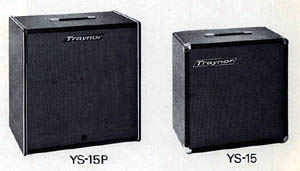
Features
silvery grey grille cloth;
wheels
Sound
primarily for bass but may be used for guitar
Reliability
-
Price
US $129.99 used, good condition, seen at Daddy's Junky Music at
http://www.ugbm.com/amp.htm, September 1998
Rating
-
Rate the YS-15(P) cab...
 YS-15 and YS-15P cabinet, catalog page YS-15 and YS-15P cabinet, catalog page
 YS-15 cabinet with a Goodmans Audiom 15" driver (pictured under a Sears Silvertone twin twelve that is used for bass) YS-15 cabinet with a Goodmans Audiom 15" driver (pictured under a Sears Silvertone twin twelve that is used for bass)
 Unknown 1x15" cabinet (the one on the bottom with the logo on the front) Unknown 1x15" cabinet (the one on the bottom with the logo on the front)
(Dan Lear,
Eric Knudsen,
Max Currie,
Moon Keith,
Vince Grienti)
|
|
|

|
YS-18 cabinet
100 watts,
1x18" cabinet,
1967
|
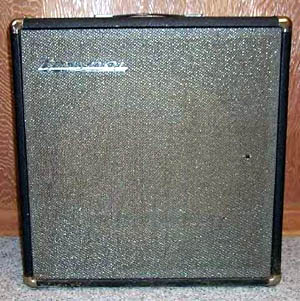
Features
-
Sound
-
Reliability
-
Price
-
Rating
-
Rate the YS-18 cab...
 YS-18 cabinet, front view YS-18 cabinet, front view
 YS-18 cabinet, speaker back view YS-18 cabinet, speaker back view
 YS-18 cabinet, opened cabinet YS-18 cabinet, opened cabinet
(ebay.com,
Paul Bechtoldt)
|
|
|

|
YB-18(A) cabinet
100 watts,
1x18" cabinet,
1960's?
|
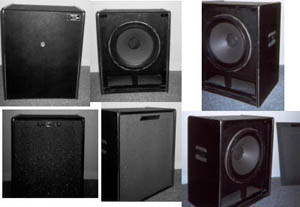
Features
silvery grey grille cloth
Sound
excellent for bass guitar
I have picked one of these gems [YB-18A] up from a sale a while ago... The single 18" [with] a folded W Horn! There really isn't anything like it I have ever heard. The thing is huge though and not really practical. [...] There can't be many of these things left. [...] I was told the 100 watt Marshland was replaced with a Peavey BW 300 18" [speaker] but I haven't tor[n] it apart to verify. (Blair)
Reliability
-
Price
YB-18 (not the YB-18A) for 150$ CAD. It was upgraded to a single 18" celestion along the lines.
Rating
[The YB-18 is a] great little cab, lots of bottom.
Rate the YB-18(A) cab...
 YB-18 cabinet, various views YB-18 cabinet, various views
(Brad Ferguson,
Dan Lear)
|
|
|

|
YT-12 cabinet
? watts,
2x12" cabinet,
1960's?
|
Features
silvery grey grille cloth
Sound
very biting sharp sound with much treble sensitivity can be obtained from this
speaker cabinet; should be used with guitar only
Reliability
-
Rating
I have been using the YT-12 cabinet with my YSR-1 Custom Reverb amp for about 15 years and I will never give up my head unit or cabinet for anything. Neither one has given me any problems, and the sound quality is unmatched.
Rate the YT-12 cab...
(Dan Lear,
William M. Pearson II)
|
|
|

|
YT-15 cabinet
? watts,
2x15" cabinet,
1960's?
|
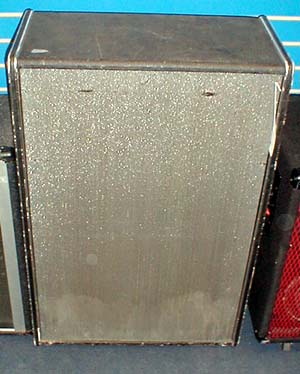
Features
The YT-15 has two 15" paper-cone woofers @ 8-ohm each, (mine dated "July 19, 1973") and logoed Yorkville Sound on gold labels. The cabinet is 16-ohm, but there is no reference to power-handling capacity. The logo plate looks like all the others except that the letters are solid & chromed instead of diamond chrome like my YSR-1 amp head. Cabinet is black
tolex, silver/black grille-cloth like the YSR-1, and has the same "auto-door-strip" moulding as the YSR-1 head. Also one 1/4" speaker jack on the back.
16 ohms, with two Marsland 15" [speakers]. Very small and light magnets.
[a 1977 is] black with the black plastic fabric and [has] the baby bumper trim
Sound
very good deep bass sound; limited use for guitar
The YT-15 cabinet sounds great with the YSR-1... better than my old '82 4x12 Marshall does!
Reliability
-
Price
[US?] $100 [used], a 1977 YT-15 together with a 1978 YBA-1, both mint
US $200 [used], a 1973 YT-15 cab with a 1973 YRM-1 Reverb Master head
CAD $189 [used], a YT-15 (bumper version) at Songbird Ottawa (Dec 2004)
I found a Traynor YT-15 cabinet in a used furniture store. I had been asking the owner about two speakers he had for over three months and stopping by he finally had them uncovered enough to see. It is a late 60s I believe with a 4 digit serial #. The bottom was quite moldy but it cleaned up well and the inside was like new. I think I got a steal for $10.00.
Rating
I have a 1977 YBA-1 [Bass-Master] with a matching YT-15 cabinet [...]. This must have been one of the last real Traynor amps made... how about that! One of the last! It's probably not worth a tird as a collector's item but this amp really screams. It's a keeper!
I have [an YT-15 cabinet] it works great [with an YBA-1A Bass-Master Mark II] - one of the speakers is ripping but it still sounds great.
Rate the YT-15 cab...
 2x15" cabinet, YT-15, front view (early wrap-around version) 2x15" cabinet, YT-15, front view (early wrap-around version)
 2x15" cabinet, YT-15, front view (bumper version) 2x15" cabinet, YT-15, front view (bumper version)
(Cavemaaan,
Dan Lear,
Dirk Spencer,
Ebay,
John,
Ken Miller,
Ron Waters,
Songbird Ottawa)
|
|
|

|
YC-810 "Big B" Bottom
? watts,
8x10" cabinet,
1967
|
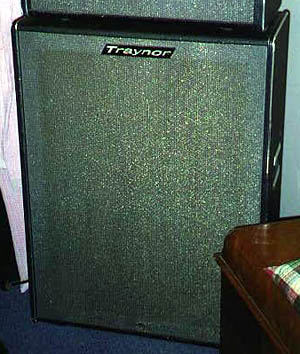
Features
silvery grey grille cloth
Sound
-
Reliability
-
Rating
Still playing out with mine. Used with the YBA-3 Custom Special Head. Love the fact that it is not too tall and I can get it into the back of the Dodge sedan (back seat removed) if I have to. The speakers are original. The old timers love it and everyone has a story and fond memories of this unit. Most all wish they had held onto theirs. Durable and reliable I receive compliments about the tone. I've been able to get the sound I desire in just about any room. I've never run out of head room. This cabinet moves alot of air, has all the bottom I want and plenty of PUNCH.
Rate the YC-810 cab...
 YBA-3 Custom Special and YC-810 "Big B" speaker cabinet, front view, angle YBA-3 Custom Special and YC-810 "Big B" speaker cabinet, front view, angle
(Dan Lear,
Garnet MacPhee,
HIP JONES,
Kerry Ayres,
Kraig O,
Terry Ladd)
|
|
|

|
YN-412 cabinet
300 watts,
4x12" cabinet,
1970's?, 1981?
|
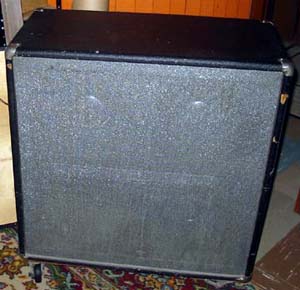
Features
Set for 16 Ohms; Tolex cover; silver grill cloth which can be easily removed
for speaker access;
No casters, black tolex body, side handles;
Available as slant top and as straight bottom cabinet
It has square magnet Emminence speakers, stock I guess. It seems pretty sturdy;
a diamond shaped port hole [is] in the front center of the cabinet;
(Is this the same model as the following?)
It had 4 Norelco 12" speakers. "Free moving speakers with 'whizzer' cones for
ultimate highs while retaining deep rich body. Must not be used for Bass."
Dimensions: 32 3/4" x 30 1/4" x 13"; weight: 107 lbs.
Sound
It's not a harsh sounding cabinet, like some Marshalls can be; nice warm tone
[Use with a Traynor head and a Strat resulted in the] cleanest sound I've
ever heard [...] and when [a overdrive pedal was added, the sound got] so
smooth, yet crisp. I swear it was a tube amp, but it wasn't.
I have a Traynor Mark III head with a Traynor YN-412 cab. I took out the whizzers (sounded kinda crappy) and replaced them with Eminence Legends (4 ohm). I was in a band with a guy who had a Marshall tube amp and a 1960 cab... My rig was and is way bassier and smoother. Paid $325 for the Mark III head and $140 for the cab. plus $120 for the replacement speakers. $585 for a rig that surpasses the Marshall by volume (check out the RMS of a Marshall and the RMS of a Traynor... hands down a Traynor slaughters!). [Sep 2002]
Reliability
Well it looks old, but it's a fighter.
Price
CAD $50 used, [it had only] a few scratches, [and] all it needed was a good
cleaning on the tolex; what a steal
Rating
Sounded so good clean and just amazing when [...] used [with] overdrive [pedal].
I had a YN-412 with a Mark III head. It was a great sounding amp, unfortunately I sold it a few years ago but would like it back. I used it with a Telecaster and a Takamine EF-318 acoustic. Great sound with acoustic as well.
I had a YN-412 cabinet I purchased in 1969. The actual cabinet (i.e. the box) was good construction and traveled well. The speakers however were %#$+ (expletive deleted to quote the old Nixon tapes!). The YSR-1 50 watts was way too much for those snow cones! I pulled them all and stuck them in two homemade cabinets to add to the P.A. for which they were O.K. I could only afford 1 Electrovoice SRO-12 speaker at the time ($100 in 1970) but that one speaker pushed by the YSR-1 was way louder than the other four stock speakers. Made the YN-412 a good cabinet. I always wondered what two SRO's would have sounded like. (or even better JBL's!!!)
Additional Note: I did get to borrow another YN-412 cabinet for one gig in 1971. My high school basketball homecoming dance! That double stack of two YN-412s was impressive and the stock cabinet with my SRO cabinet sounded great!
i found it in a pawn shop for [US?] $75, i opened it up and my jaw dropped when i saw it was loaded with ALTEC 417-8Hs... this is the greatest sounding cab i have EVER heard. the people at yorkville told me these were the original speakers. the cabinet is well made and sounds AMAZING. i have been known to stack it on it's side on top of a YT-212... or couple it with a '68 marshall 8x10. either way the sound is incredible. and i'm rating this cab a perfect 10.
Rate the YN-412 cab...
 4x12" speaker cabinet, front view 4x12" speaker cabinet, front view
 4x12" speaker cabinet, back view 4x12" speaker cabinet, back view
(Bernie & Michelle Girardin,
Chris Ketcham,
dhr,
Greg Gallant,
guildman,
John,
Mike Kovats,
Robert)
|
|
|

|
YC-610 cabinet
? watts,
6x10" cabinet,
19??
|
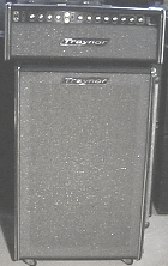
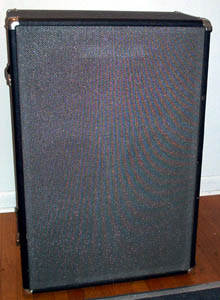
Features
bass cabinet
Impedance 5.4 Ohms.
Sound
I bought my [August 1972] YC-610 [serial no. 2081068] with a Custom Reverb head after a fellow failed to
sell it on ebay around August of 2000. He told me that people asked him
about the tone of the rig. When he responded with loud and clean, they
all lost interest. I got in my car the next day with $350 in hand and
headed to Pennsylvania to buy it. As soon as I saw the pair I was in
love. They were both spotless. I got them home and powered up. It
sounded constipated and lifeless. Our drummer was less than enthused as
I disconnected the head and hooked it up to my Marshall 4x12. It
exploded with huge, hairy AC/DC-type tone. This YC-610 was clearly no
guitar cabinet.
I promptly plugged my Ampeg V4-b head into the YC-610 and grabbed the
bass. I was again blown away. This thing moves a TON of air and can take
alot of juice without flinching. I have recorded, rehearsed and gigged
with this cab literally 5 nights a week since the purchase and there is
no sign of trouble. Every bassist who has heard or played this cab with
the V4-b has commented on the tone and talked of ditching their 4x10's.
Although it's a heavy beast, I am always willing to lug it thanks to
it's powerful and huge tone. All the clichés are there: round, punchy,
fat, etc.
I just played a show with it tonight and it was as great as ever.
Reliability
-
Rating
I have a YSR-1 with a YC-610 and an old Traynor Reverb unit. This stuff is priceless to me!!!
I use my (1972?) YC-610 with my 1972 YBA-1 for guitar and bass and I find it marvelous with both. I'm using it more for guitar these days, though. I find the sound to have a very strong but tight low end. The cab rattled a bit when I bought it a few years ago, but I just had to put some reinforcement screws inside in the appropriate places, and now it's very solid with no rattles or unpleasant resonances. When playing guitar, I can really get a TON of low end out of this thing. I've used my YBA-1 with a Sunn 2x15 cab, and I think I liked that better for bass, but the 610 does really well. I only wish I could get more low end when I'm playing bass though. Anyway, I would not trade this rig for *any* other head/cab combination. No joke. I absolutely love it.
Rating 10/10
Rate the YC-610 cab...
 1973 YC-610 cab, front view (under a 1973 YGL-3A Mark III amp) (same amp and cab as below) 1973 YC-610 cab, front view (under a 1973 YGL-3A Mark III amp) (same amp and cab as below)
 1973 YC-610 cab, front view (under a 1973 YGL-3A Mark III amp) (same amp and cab as above) 1973 YC-610 cab, front view (under a 1973 YGL-3A Mark III amp) (same amp and cab as above)
 1968? YC-610 cab, front view 1968? YC-610 cab, front view
(ae718,
Ben,
Larry Russell,
Matt McCallus,
Patrick Walsh,
Ronaldo)
|
|
|

|
YSC-2 cabinet
? watts,
4x?" cabinet,
197?
|
Features
-
Sound
-
Reliability
-
Rating
-
Rate the YSC-2 cab...
(Jean-François and Monique et Gaétan)
|

















































